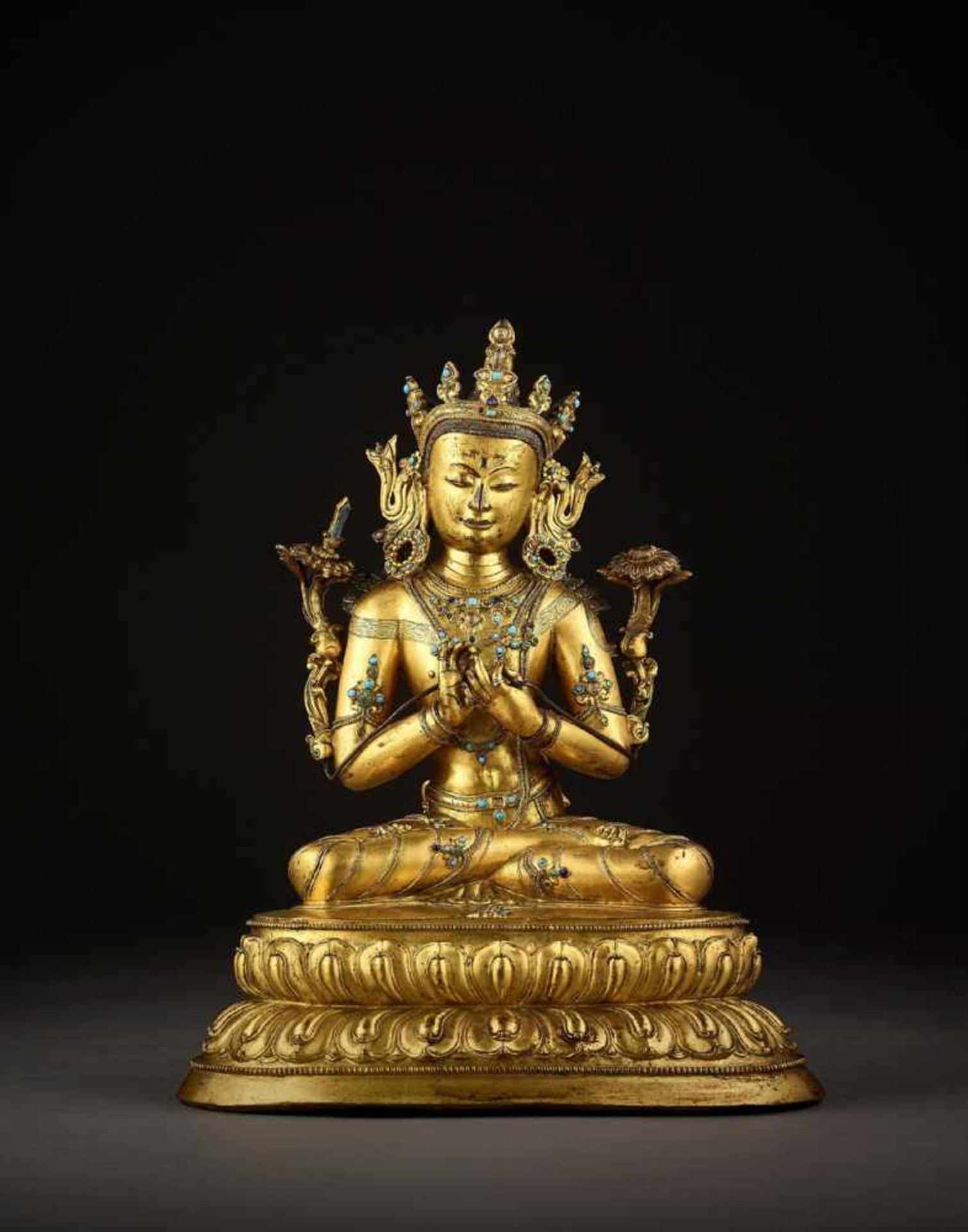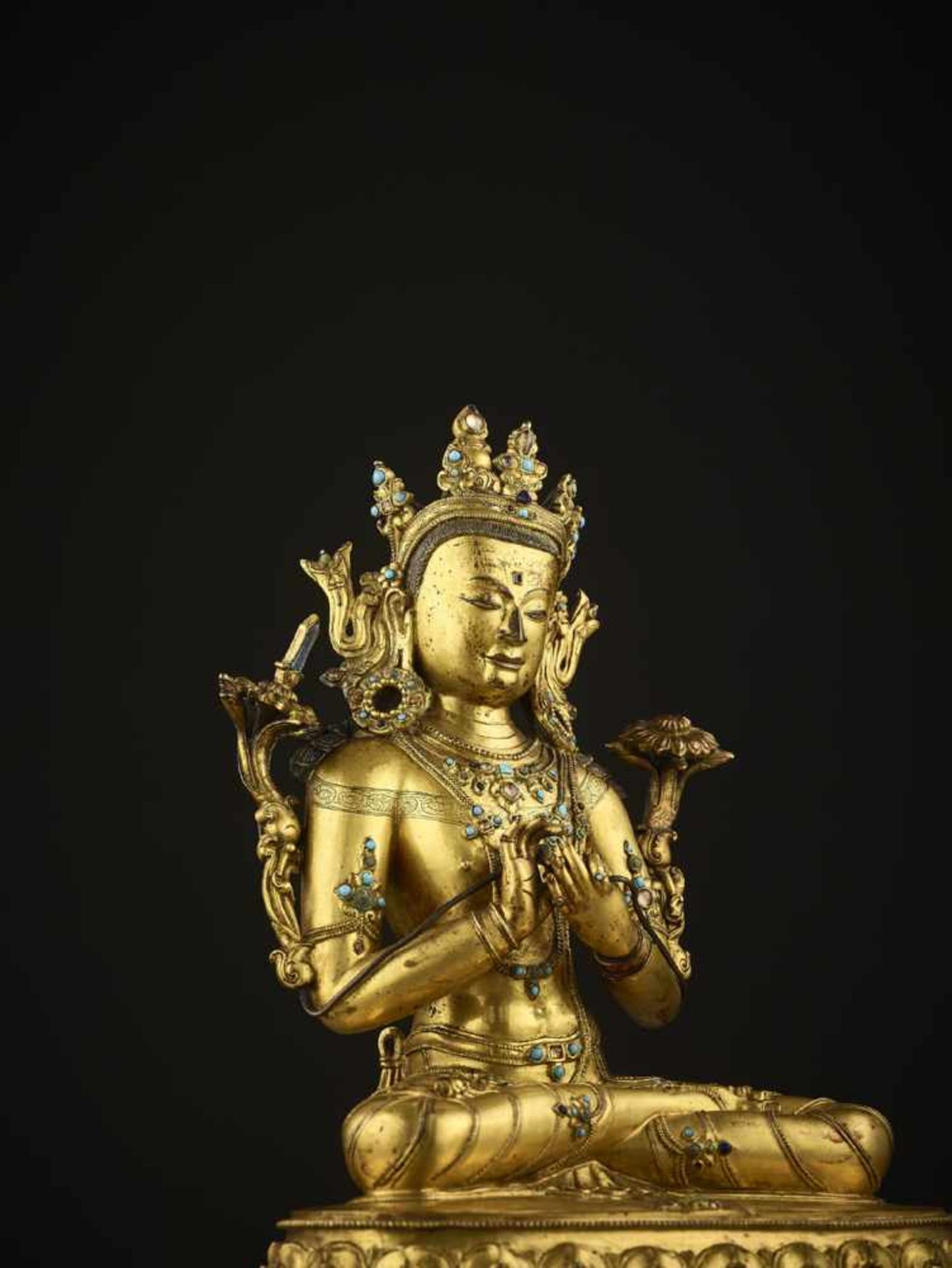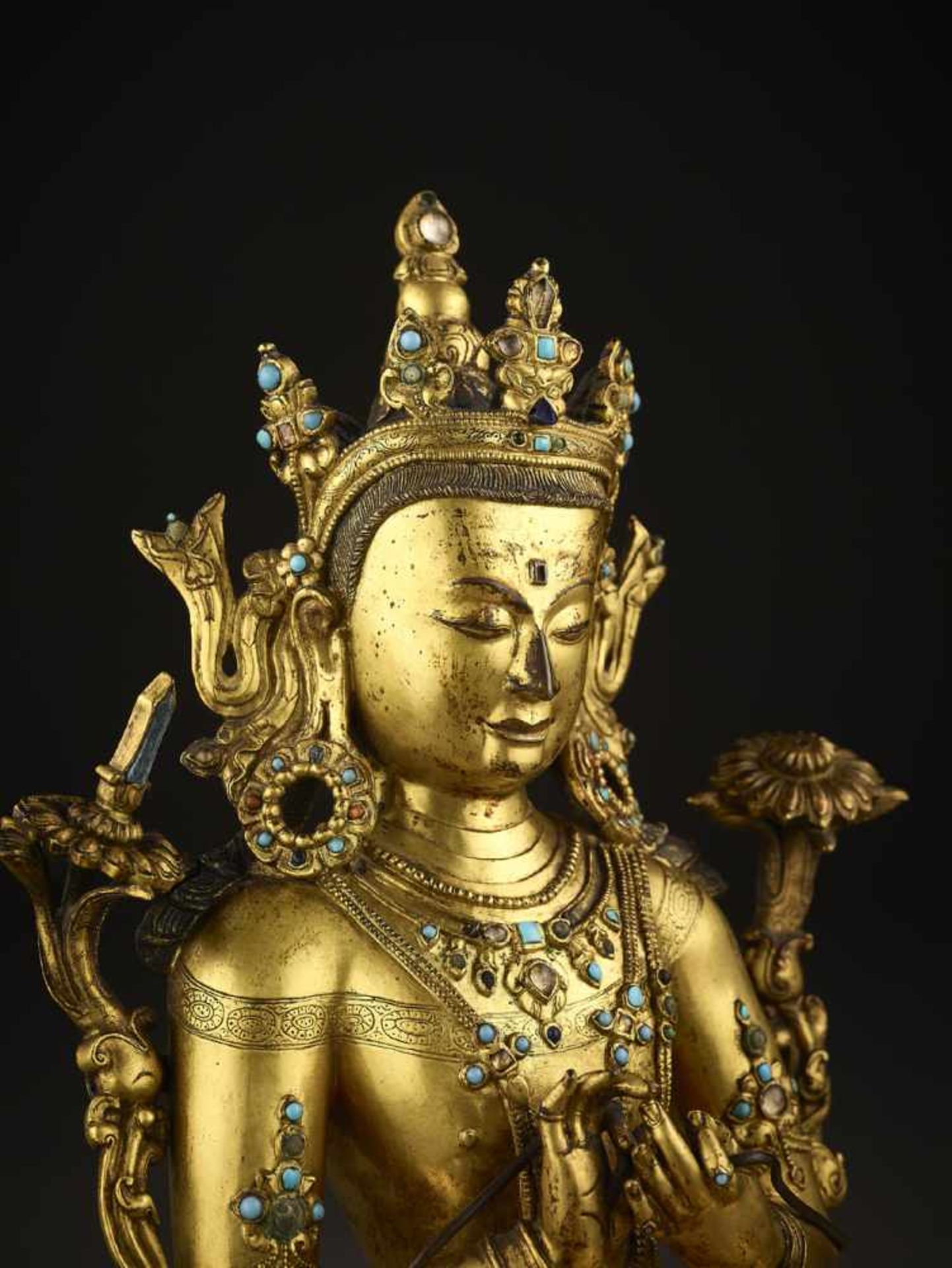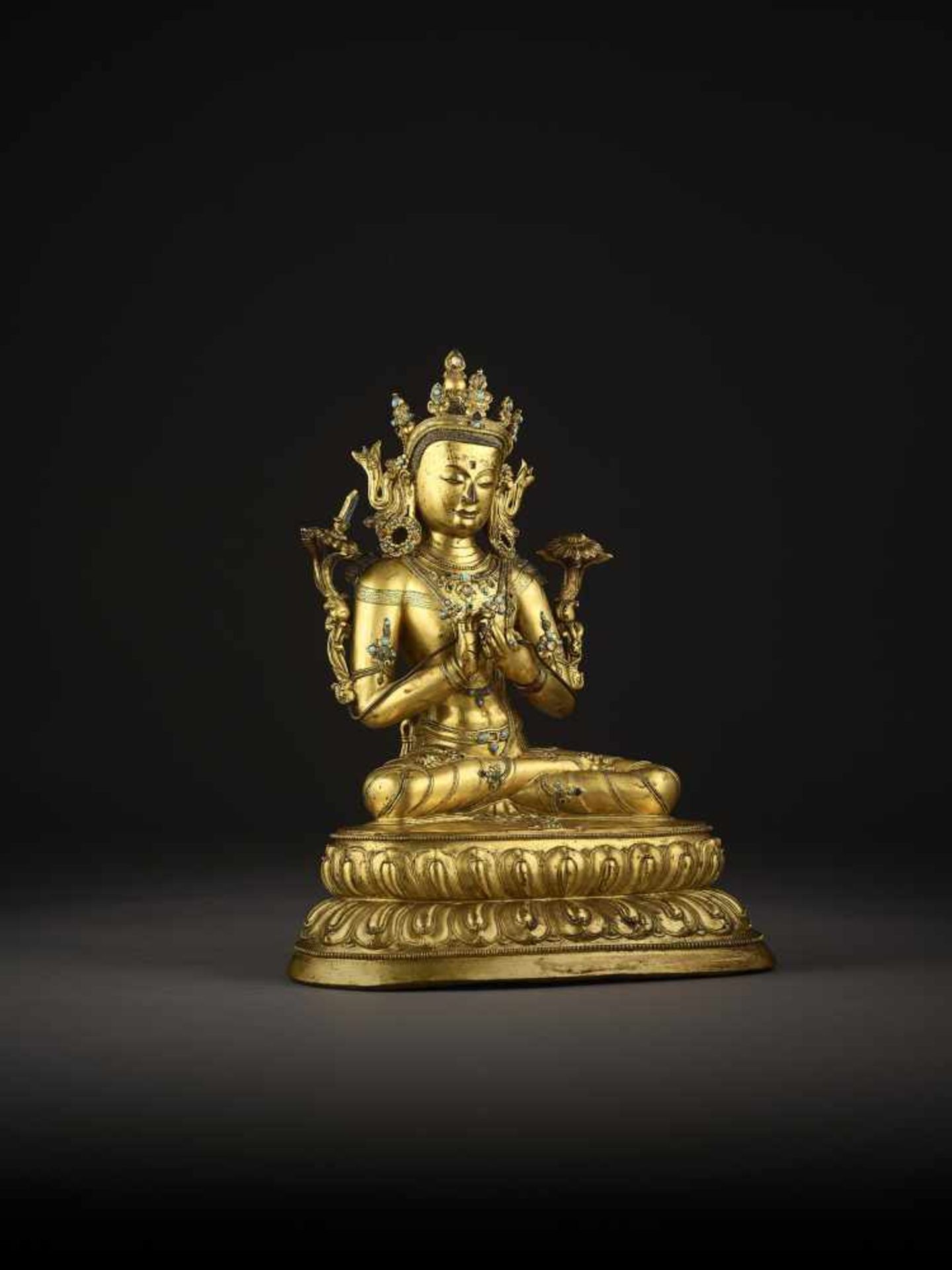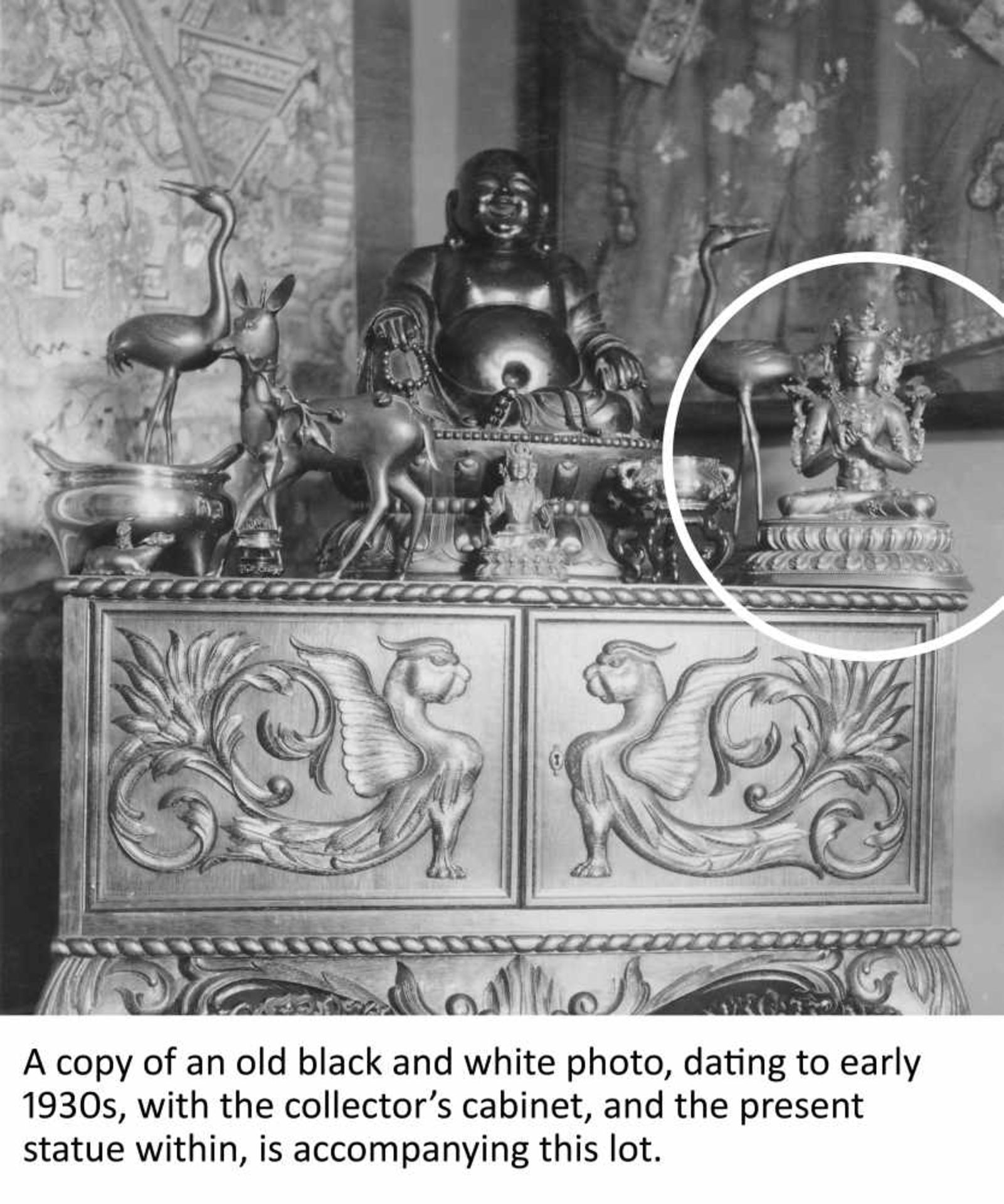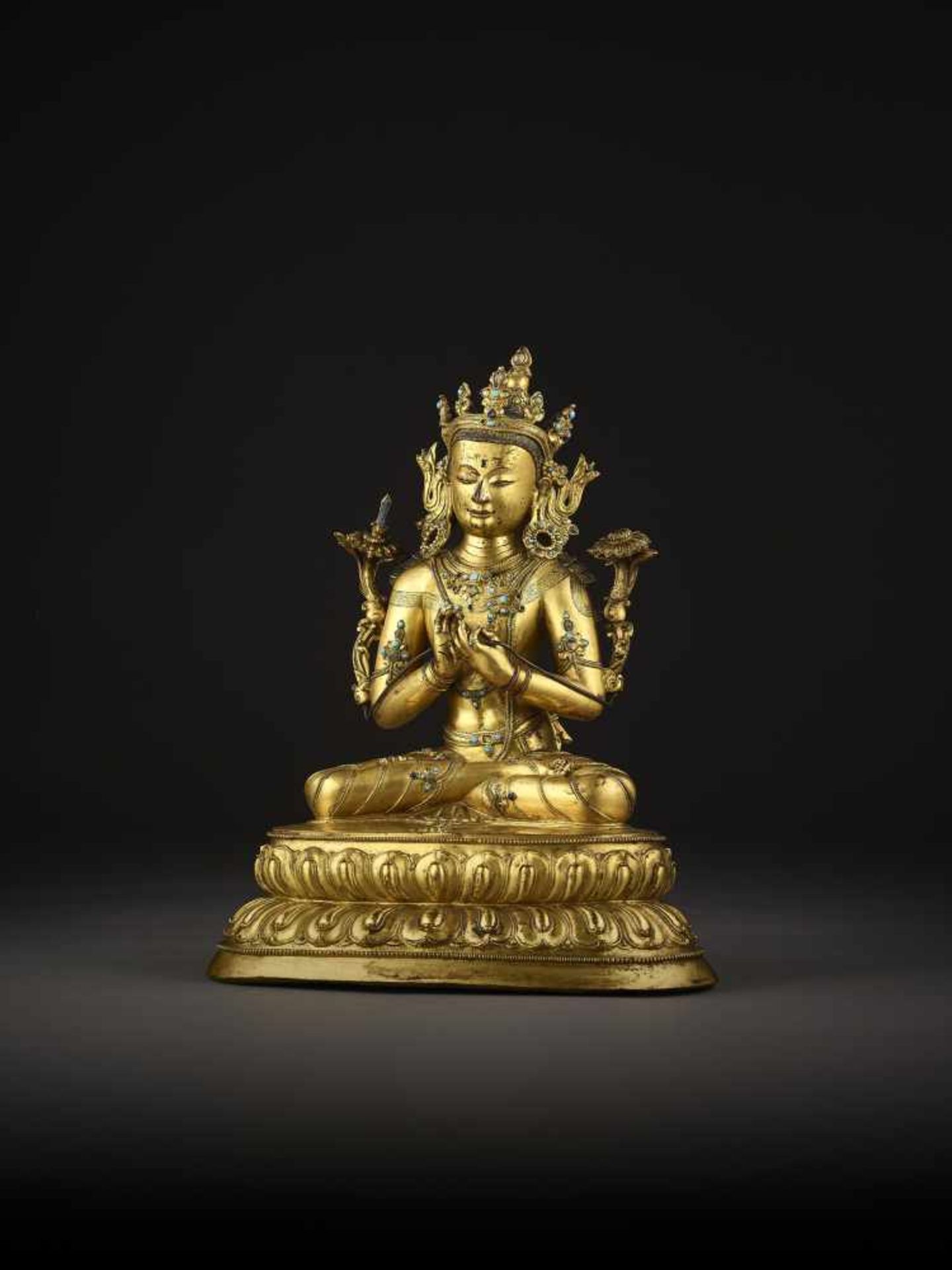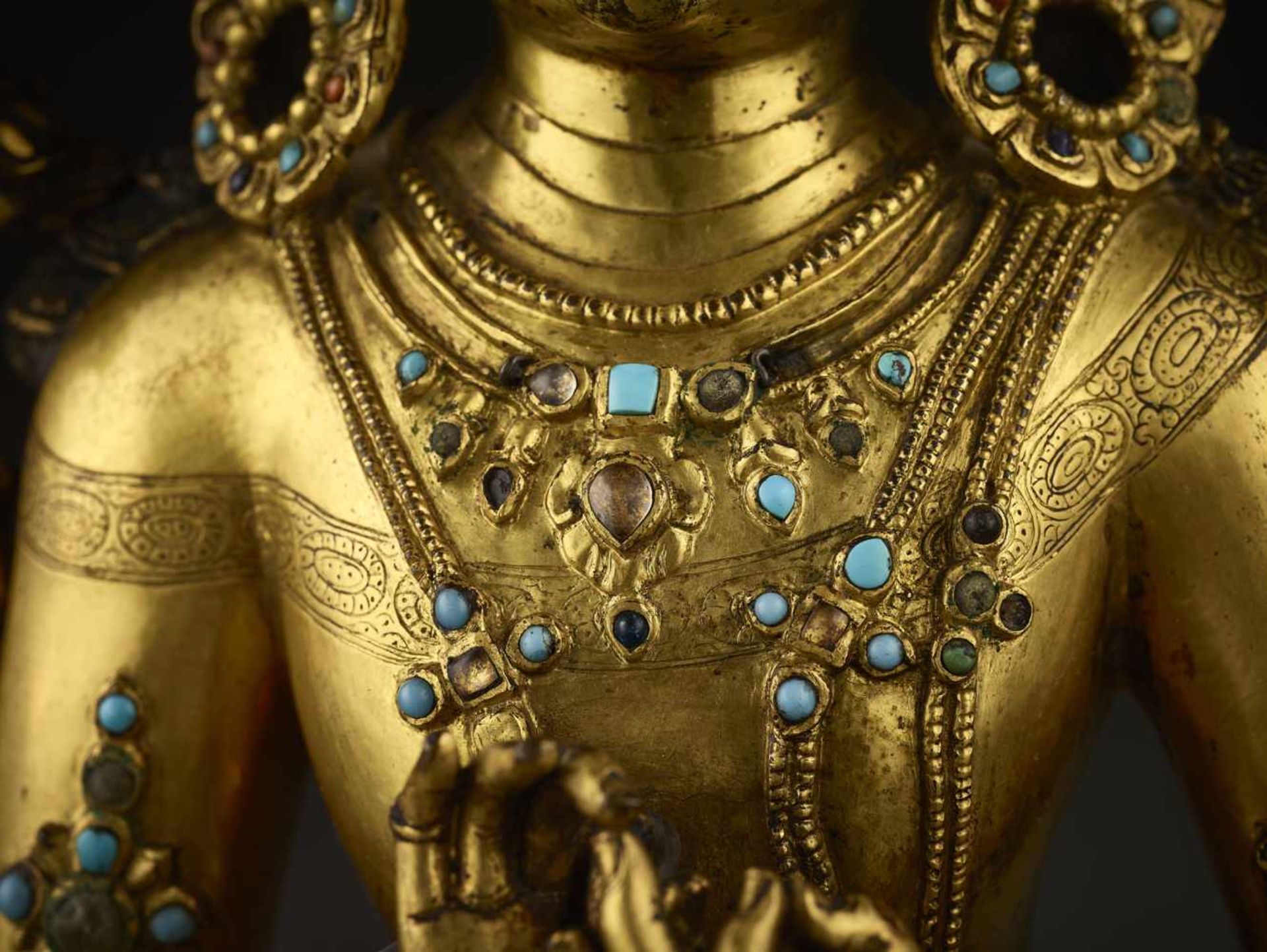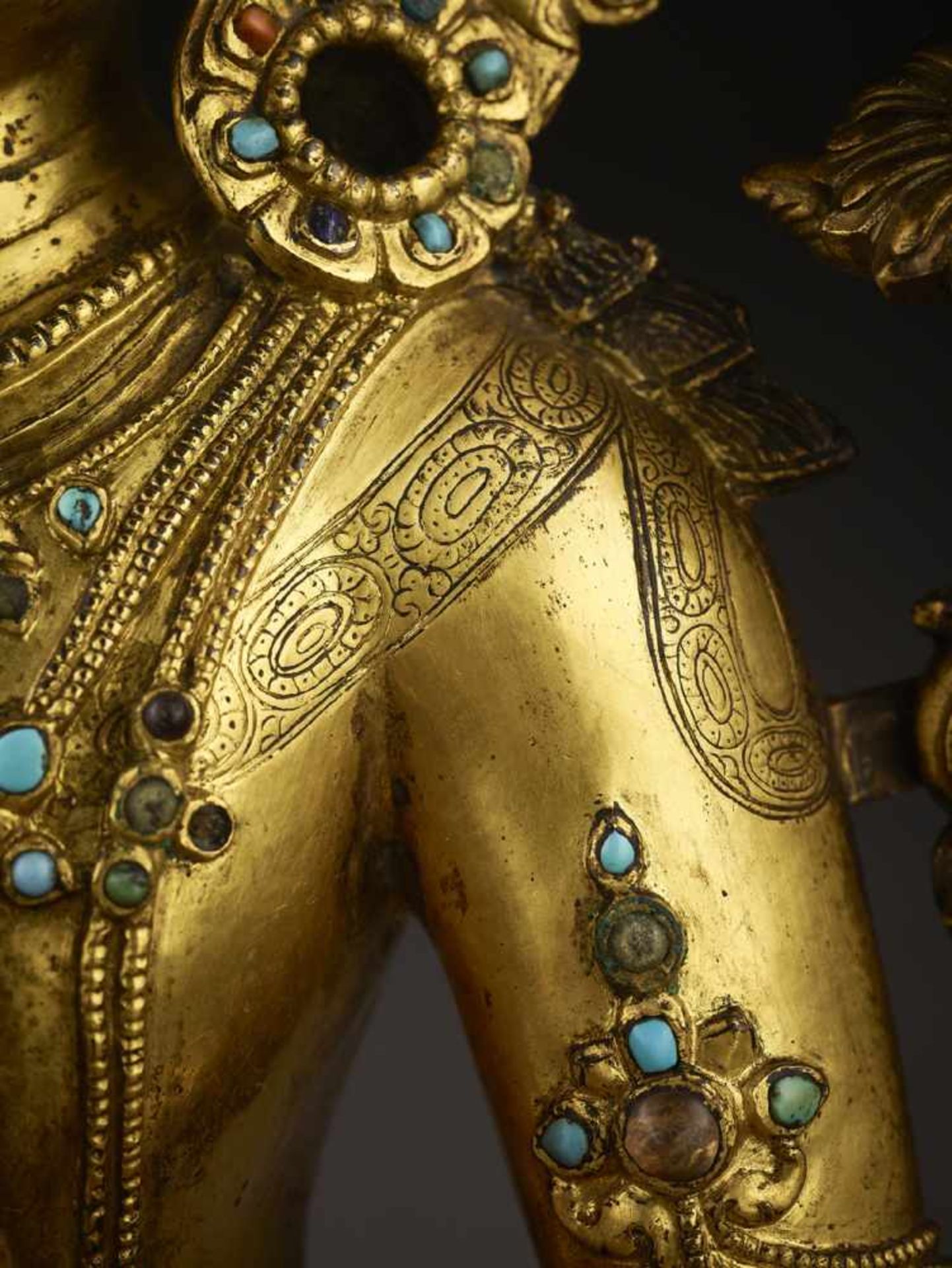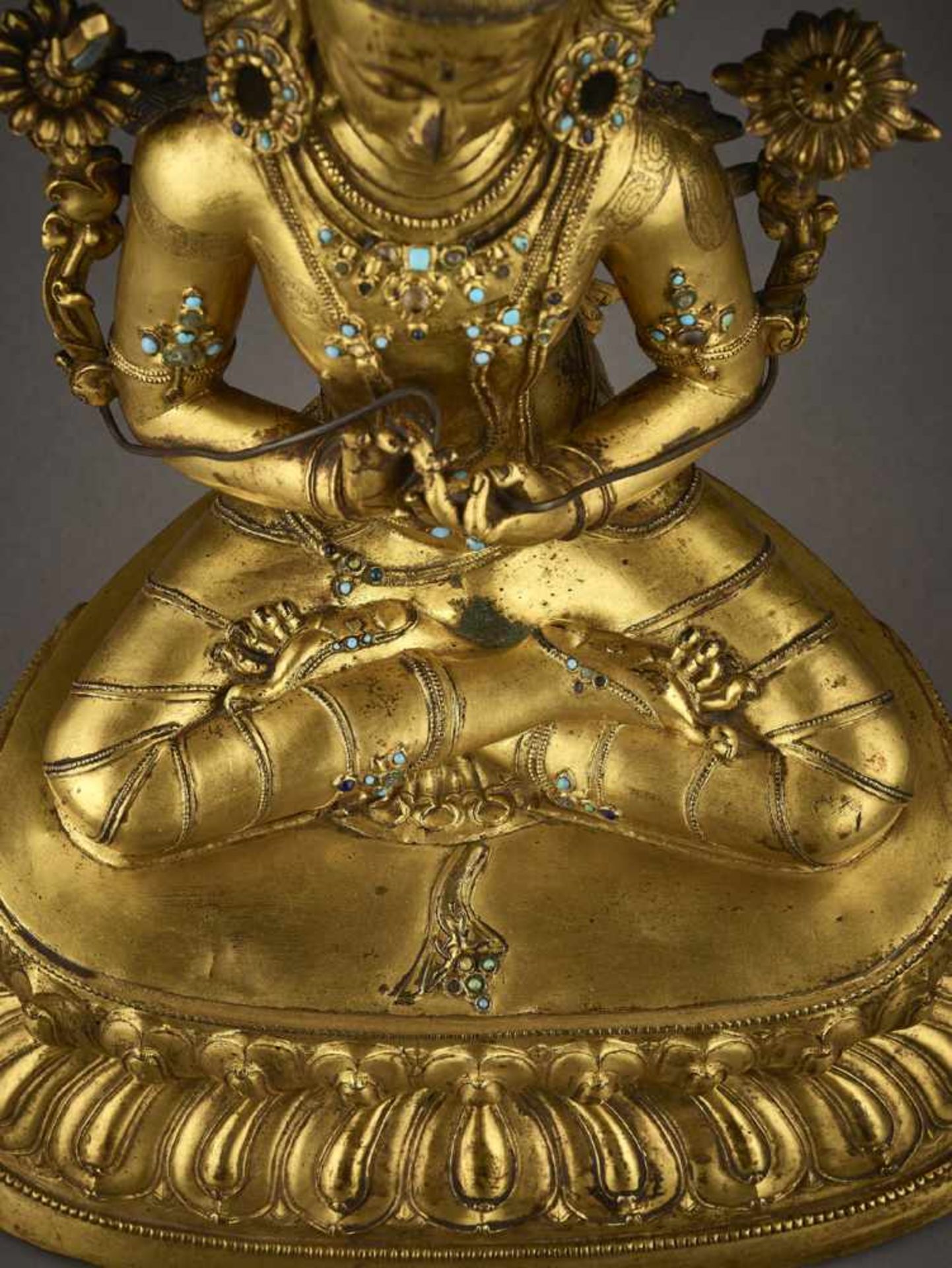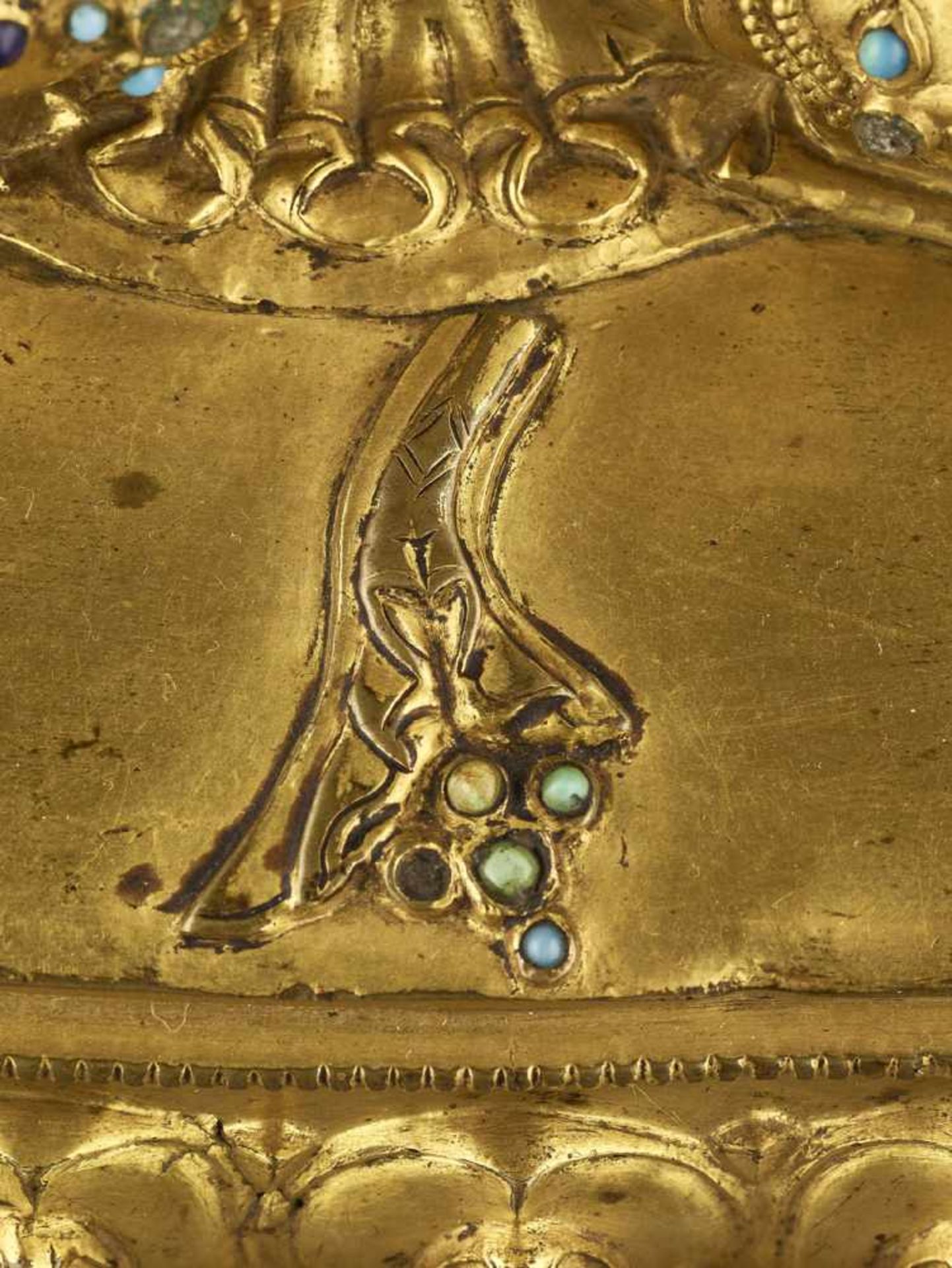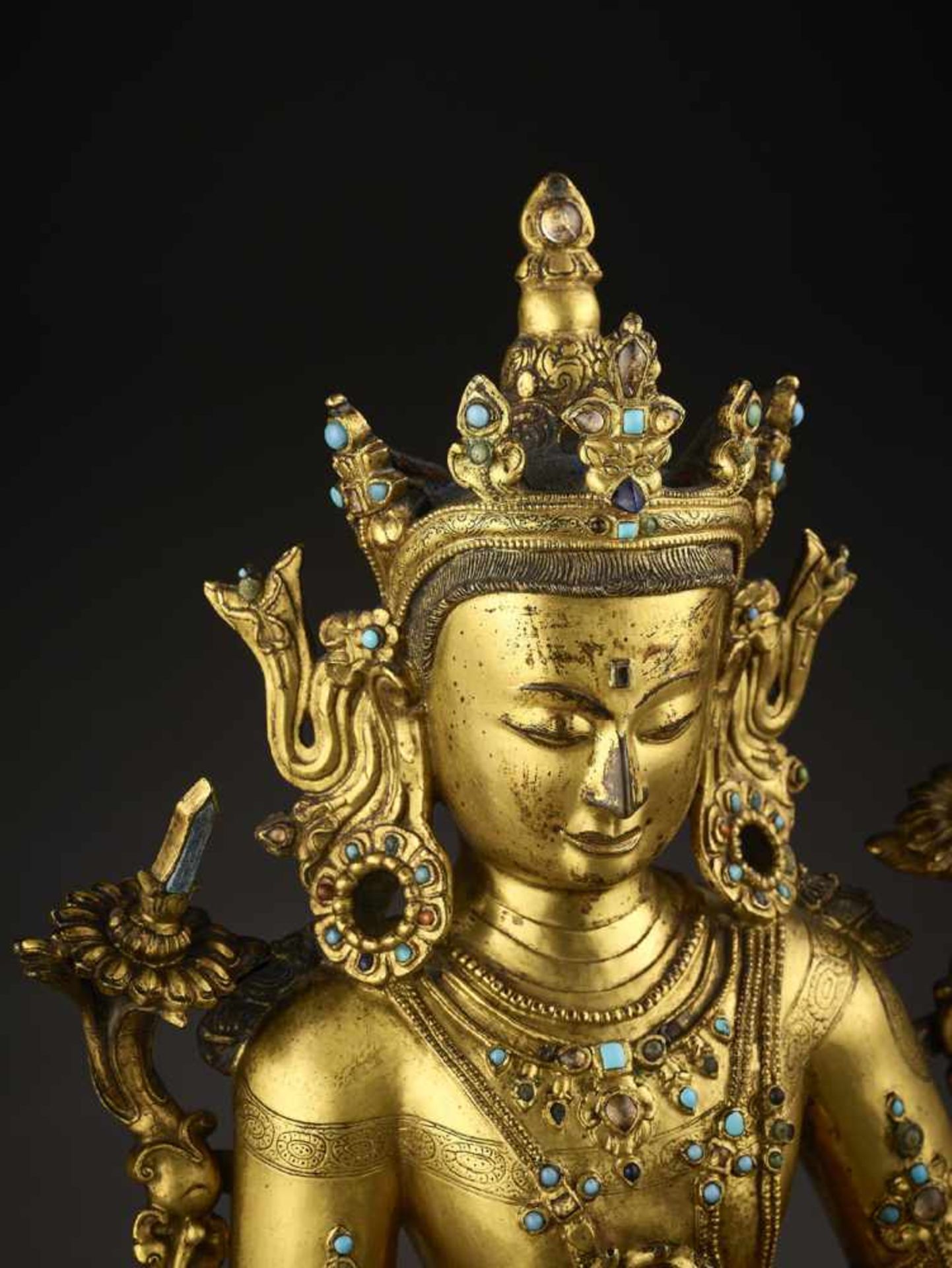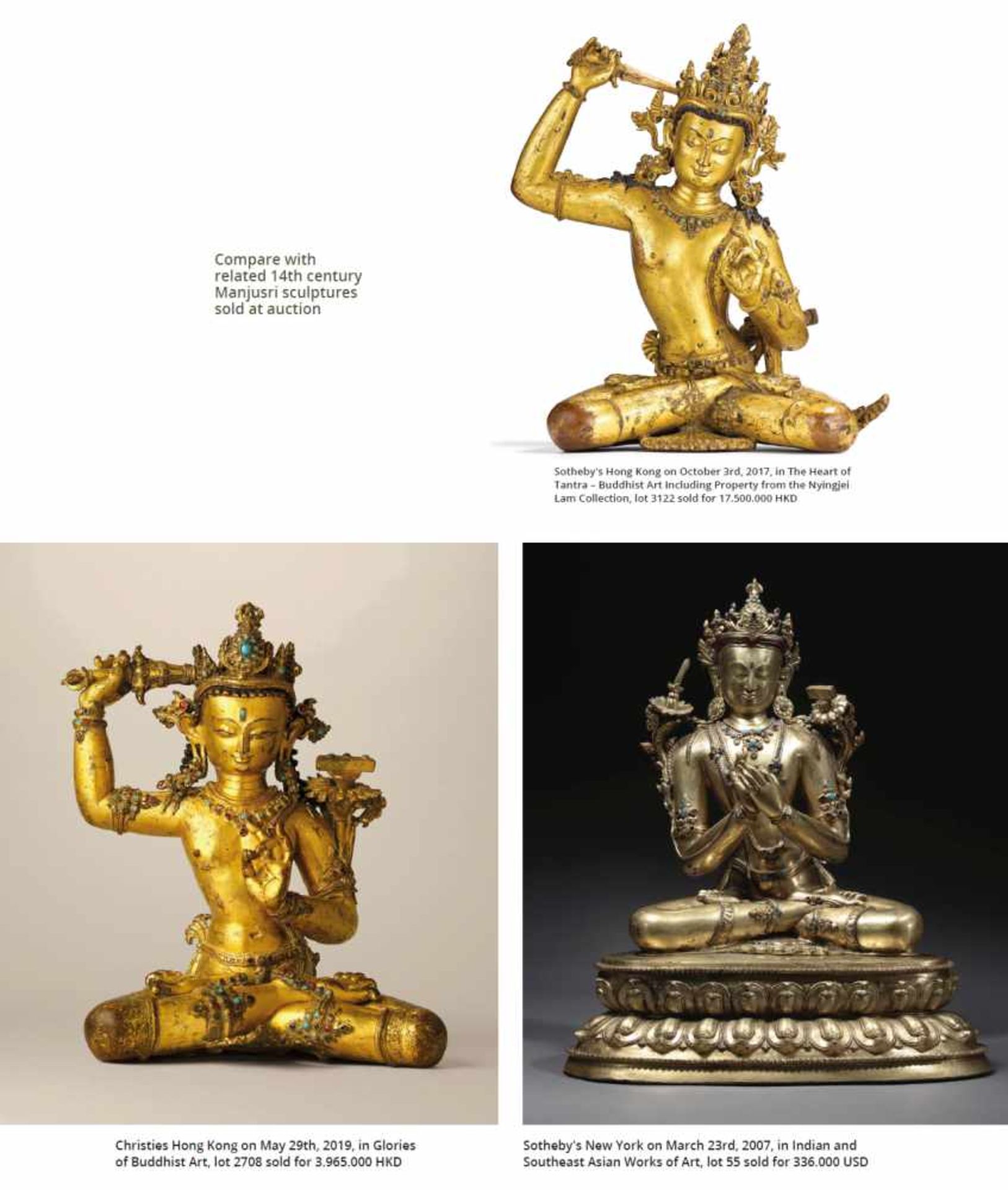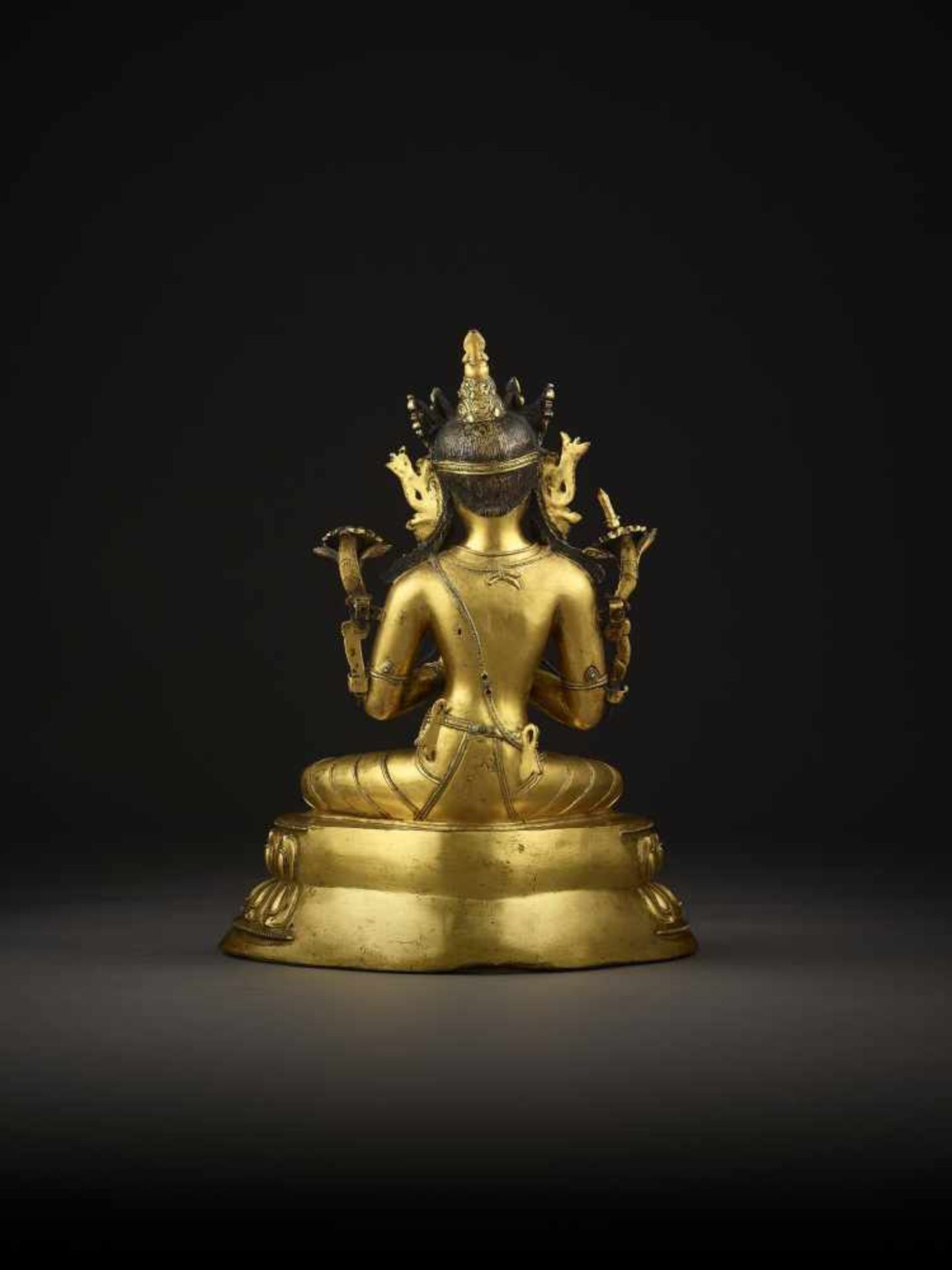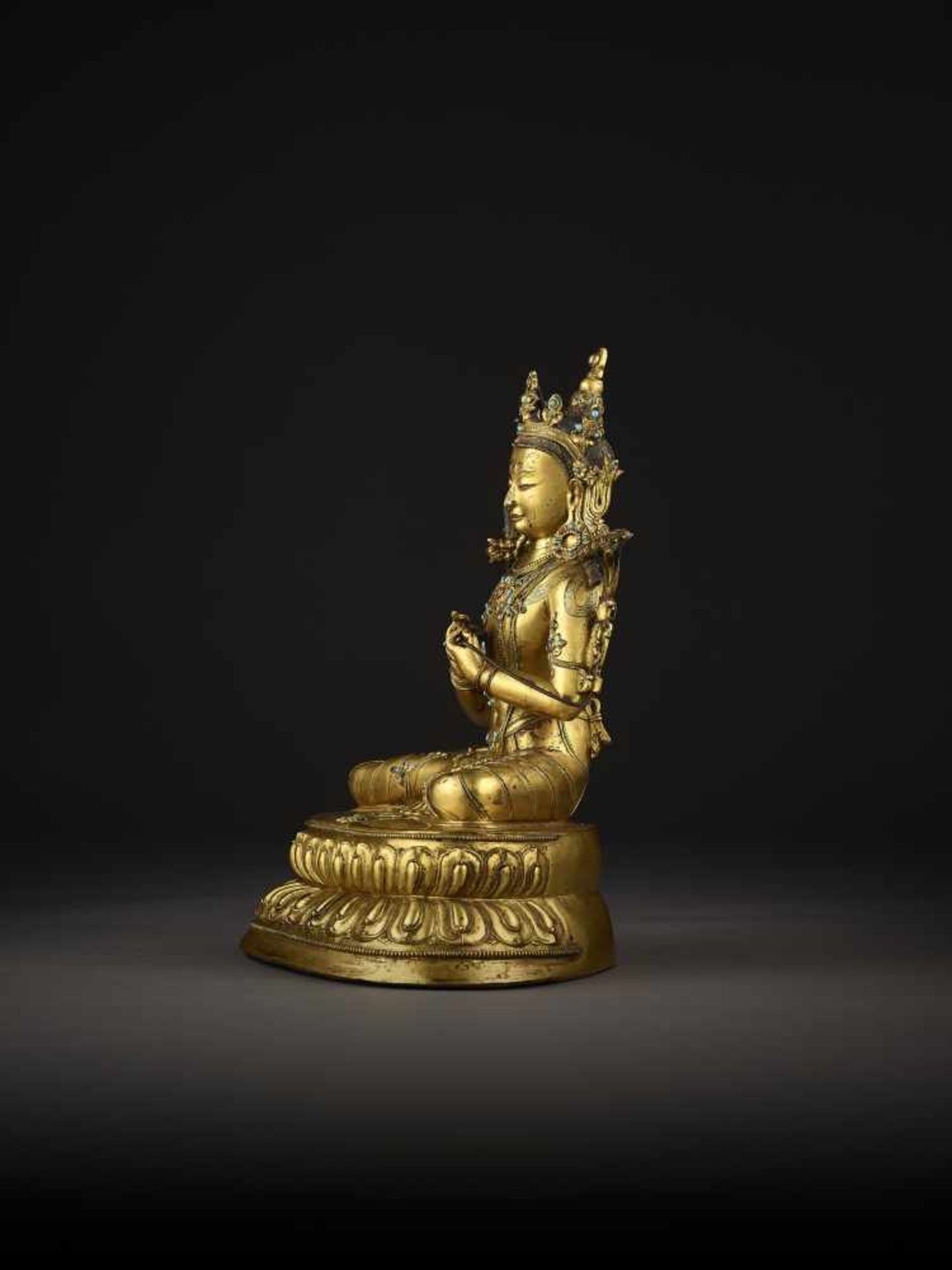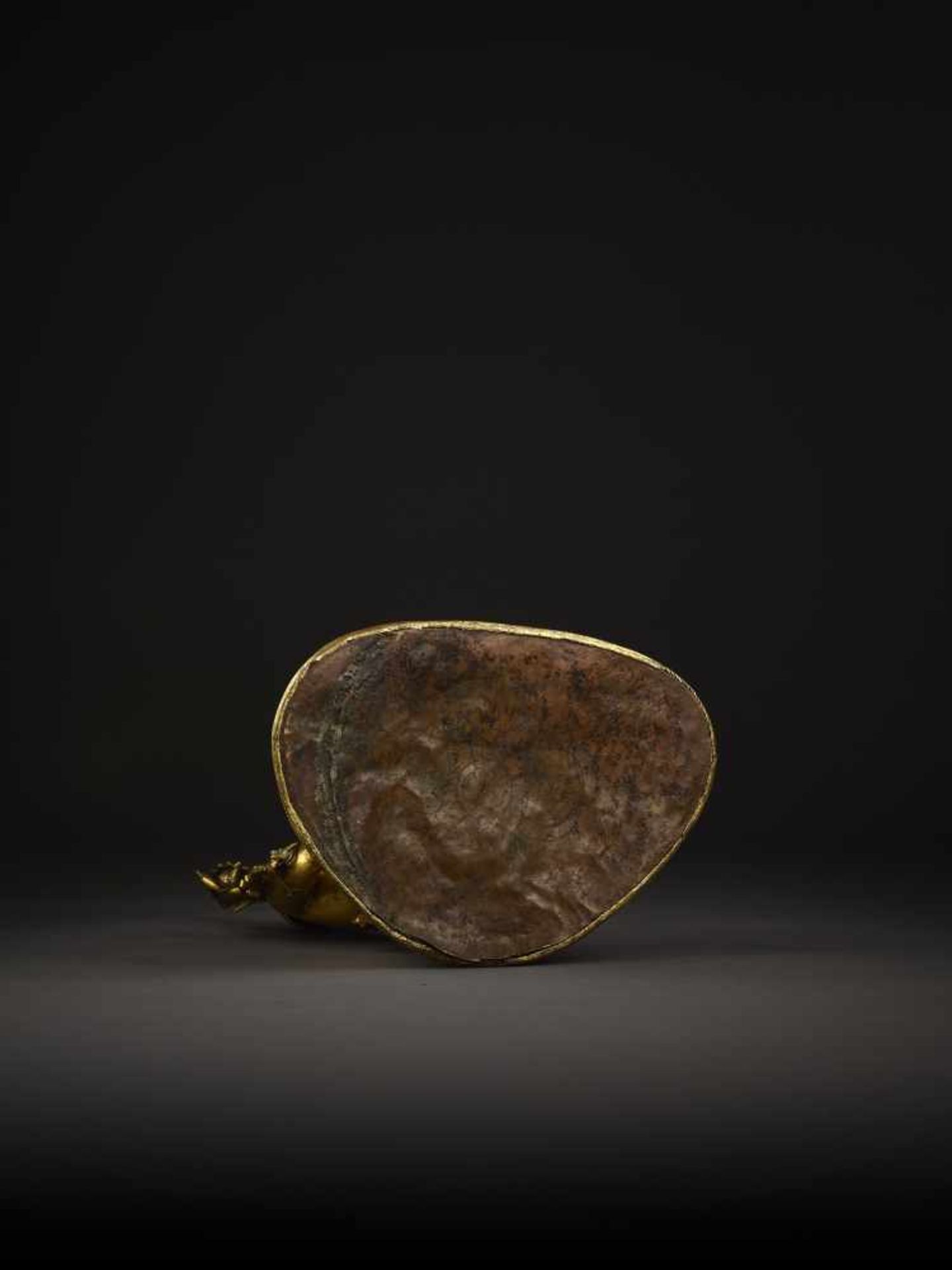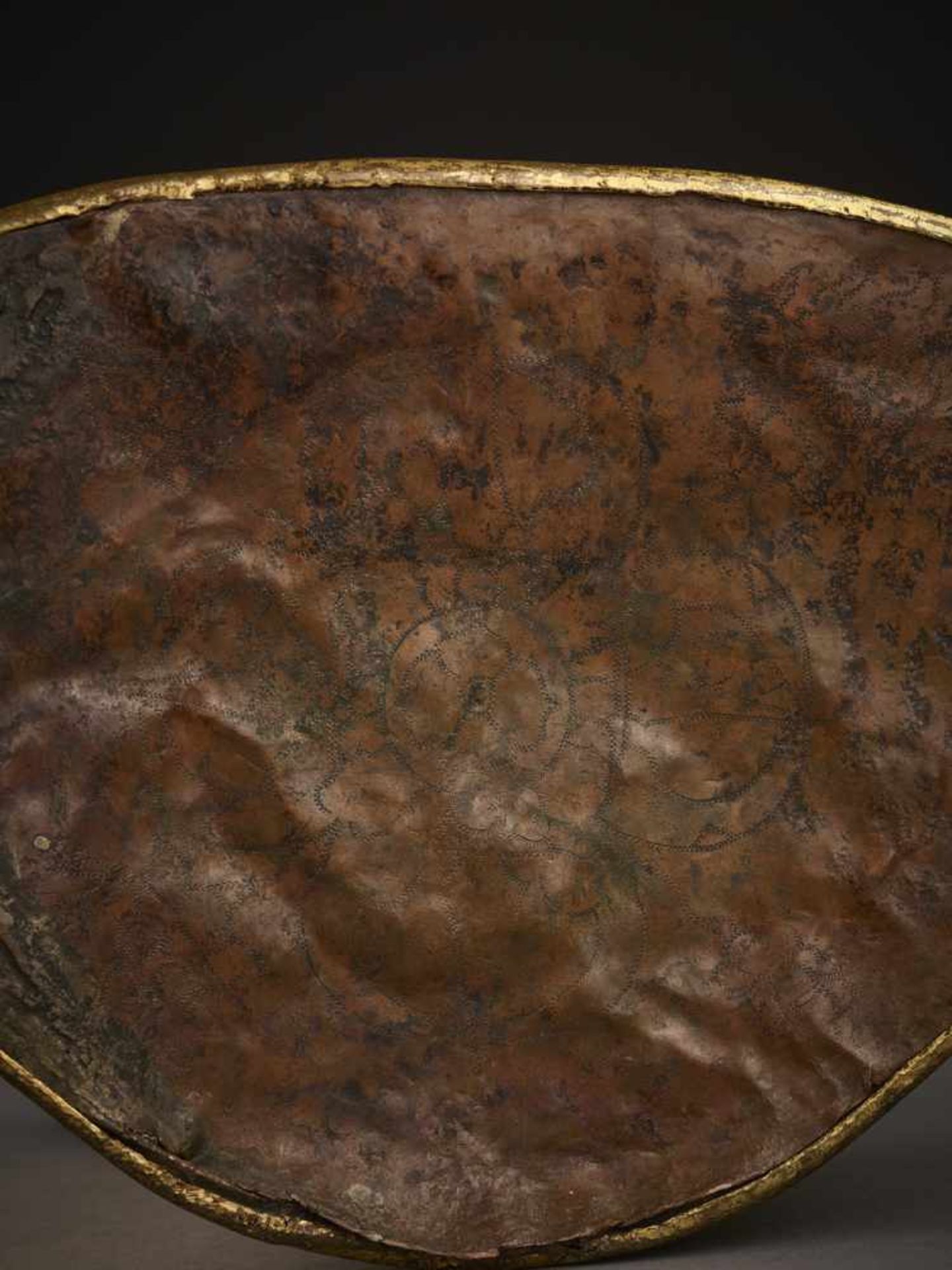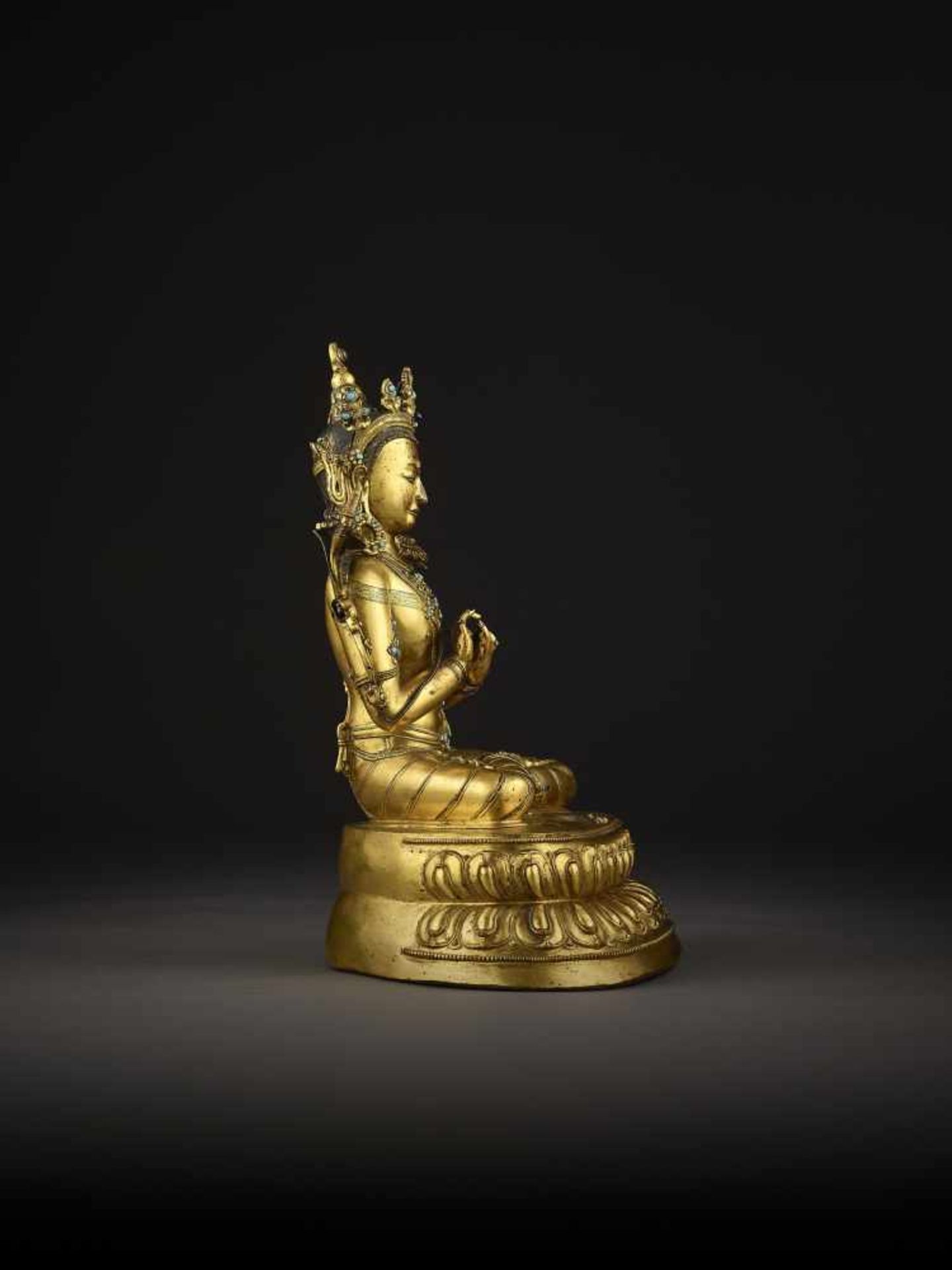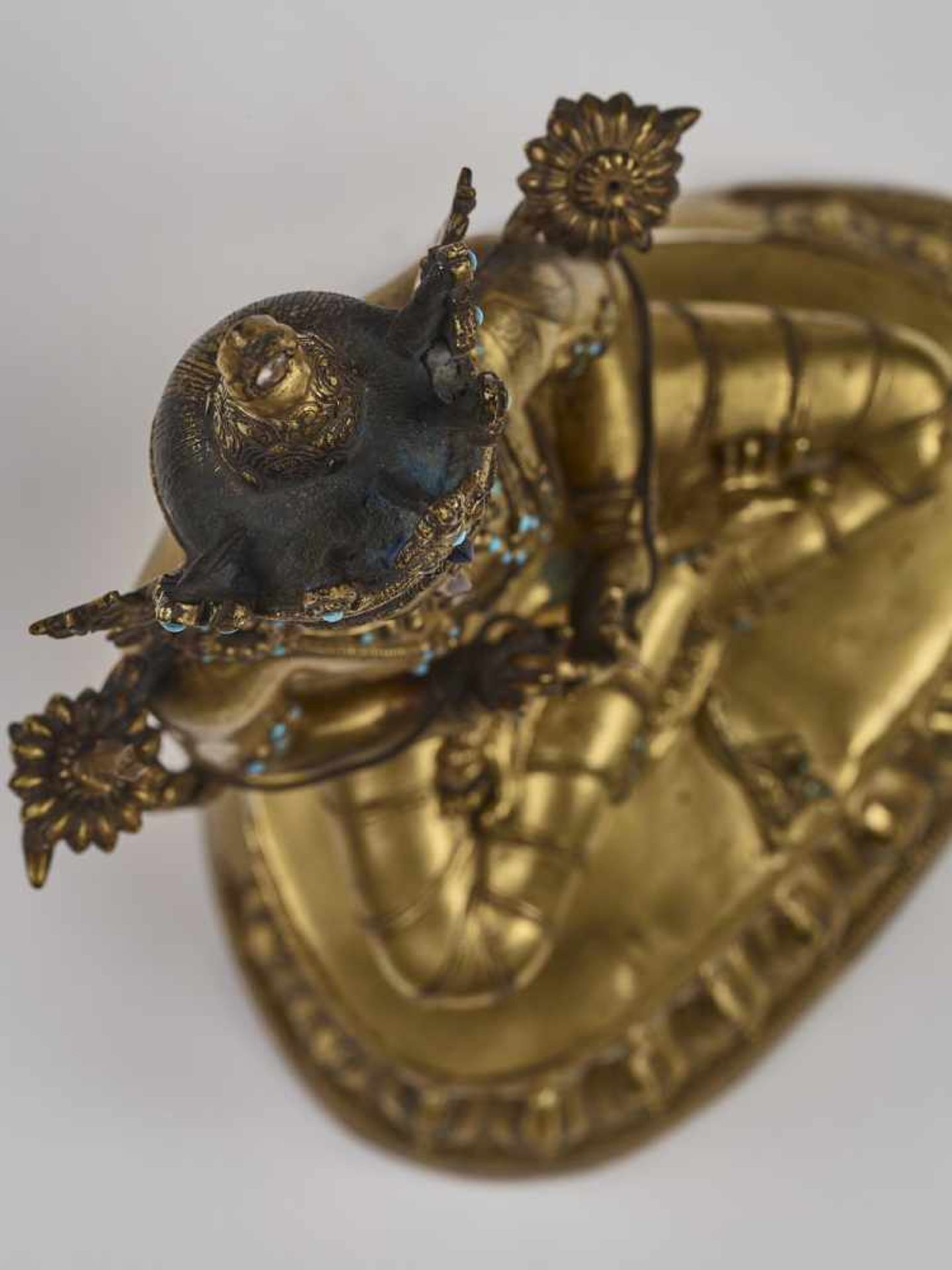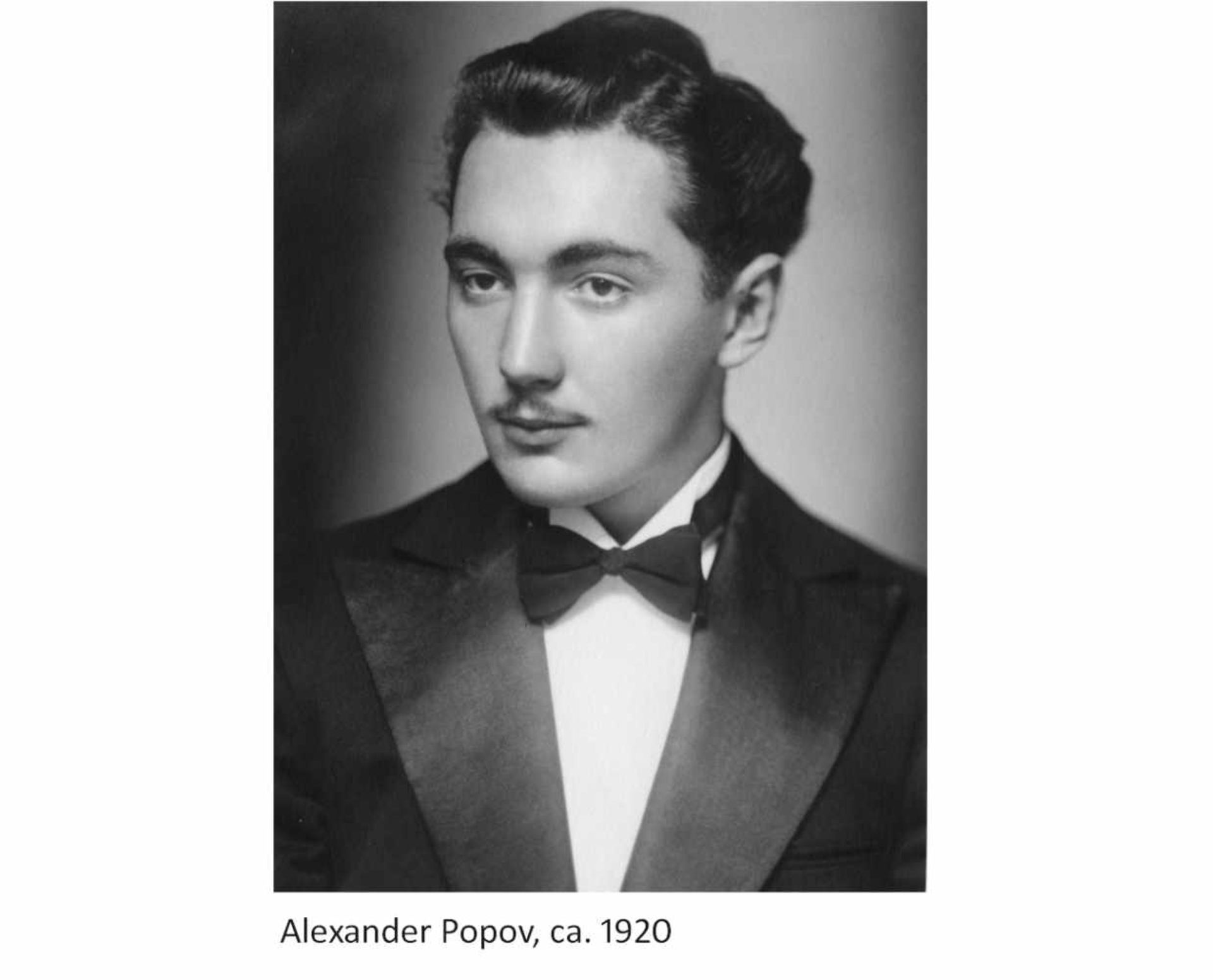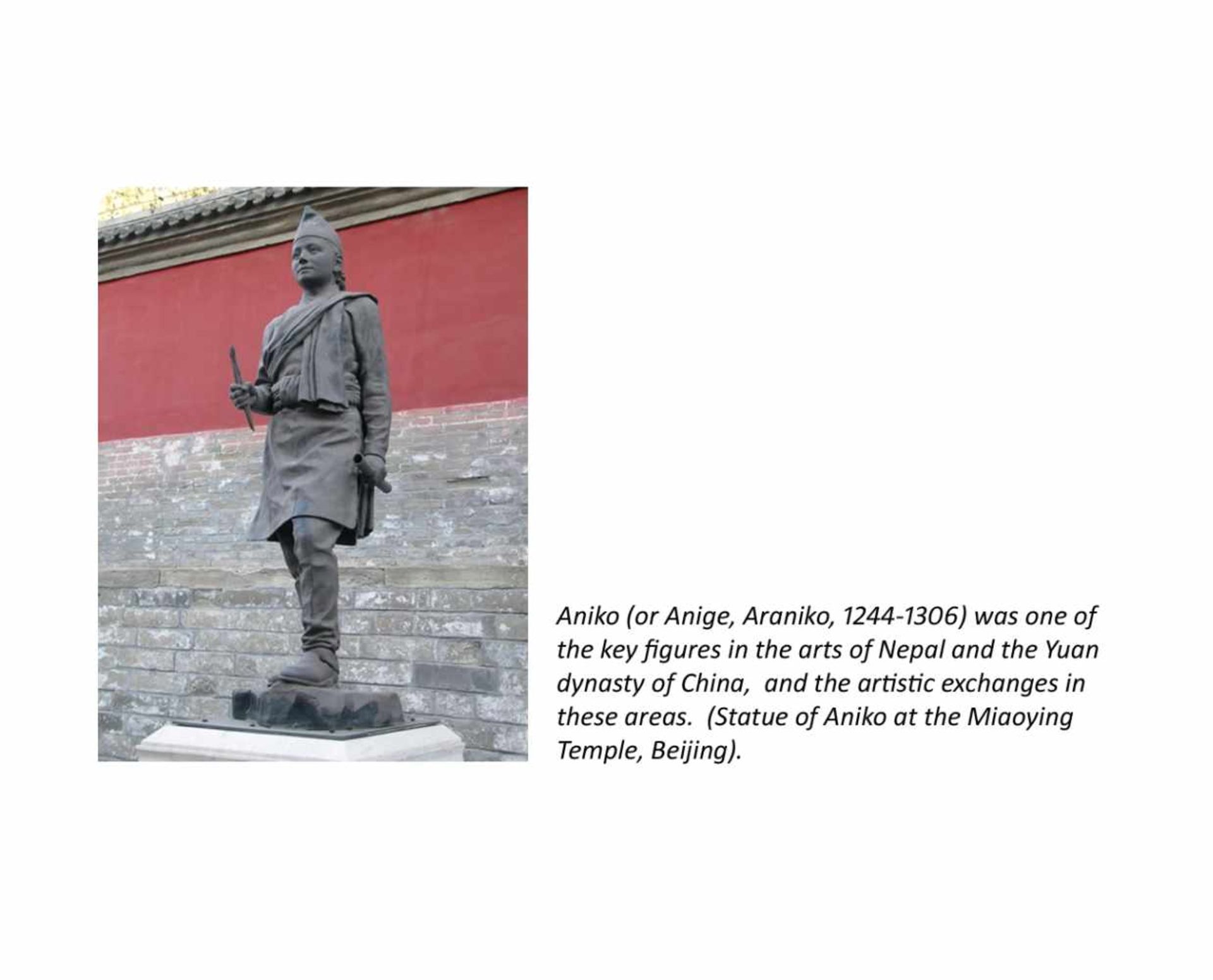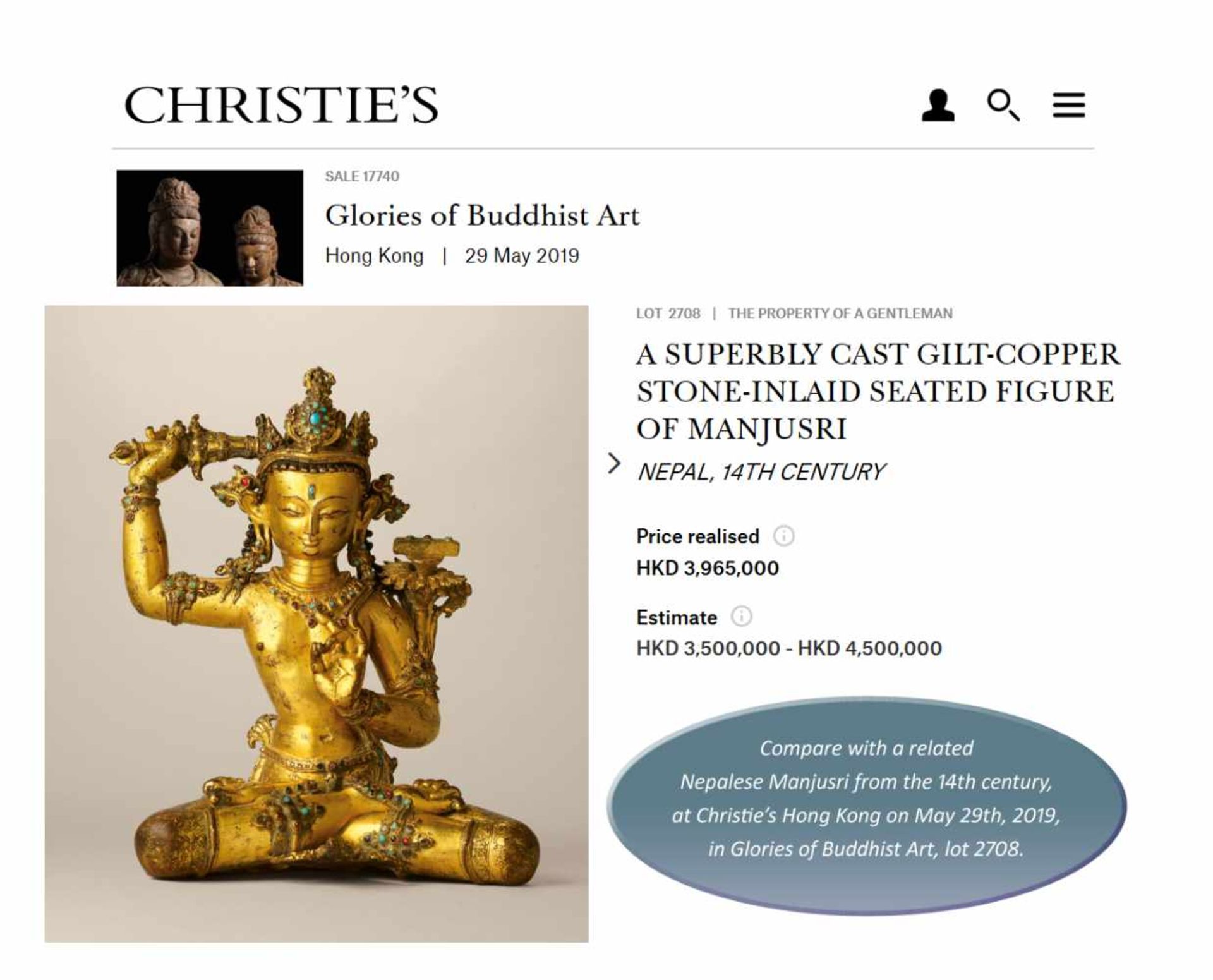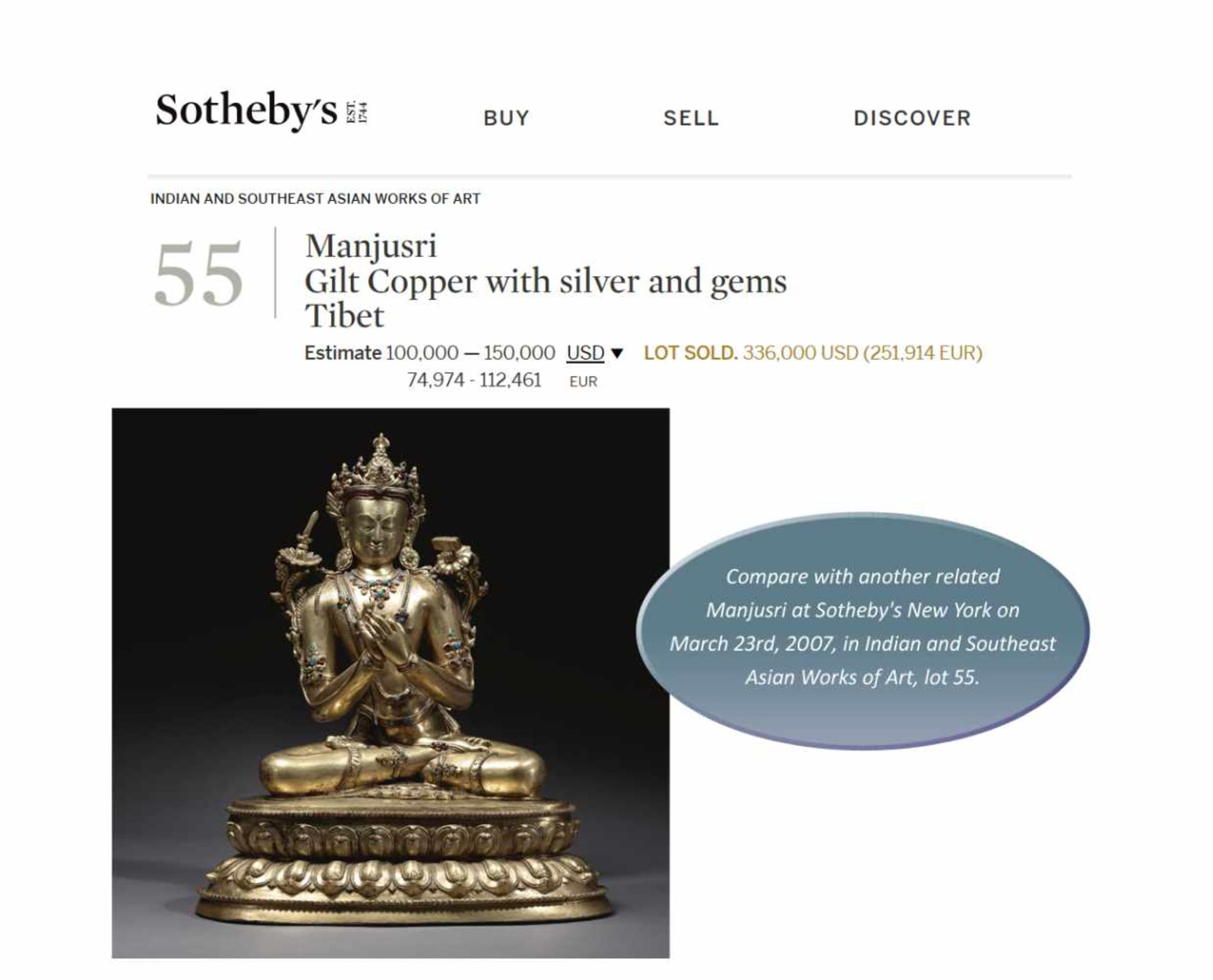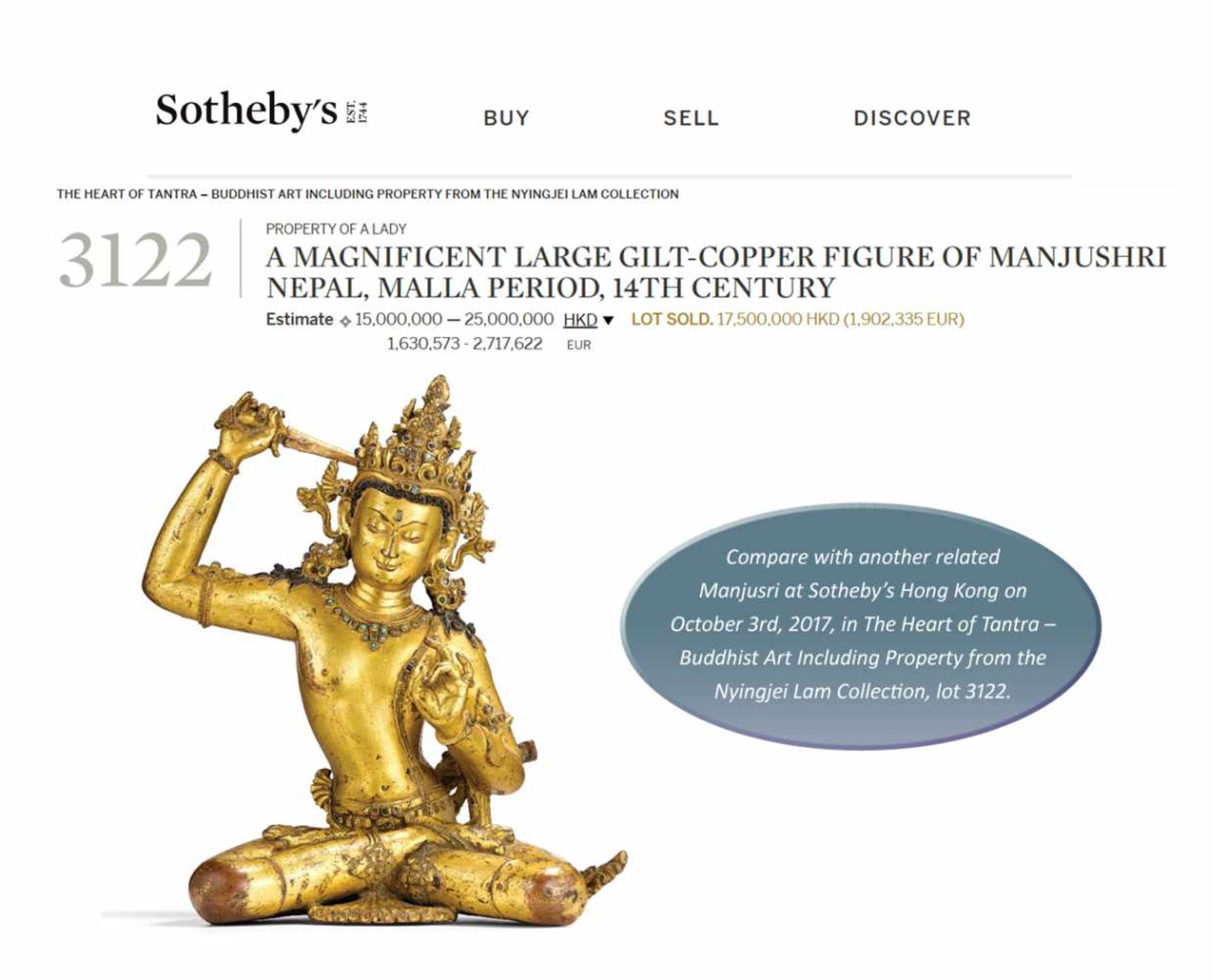48
AN EXTREMELY RARE GILT-BRONZE FIGURE OF MANJUSRI, TIBET 14TH CENTURY
The bodhisattva is finely cast seated in vajraparyankasana on a double lotus base. His hands in gesture of dharmachakra mudra holding the tips of lotus stems bearing his attributes, the sword, khadga, on his right shoulder, and the book, pustaka, on his left shoulder (the book lost).<br><br><b>Provenance:</b> From the collection of Alexander Popov in Novi Sad, Kingdom of Serbia, acquired between 1900-1920. A copy of an old black and white photo, dating to early 1930s, with the collector’s cabinet, and the present statue within, is accompanying this lot.<br><b>Condition:</b> Magnificent condition with wear and a few casting imperfections and nicks. The book lost. A copper plate marked with a double vajra is evidence of this sculpture’s formal consecration and appears Alexander Popov, ca. 1920 to be the original seal, although it shows an old repair. Some of the many inlaid gemstones and glass beads are lost, most of the remaining ones are original, a few may be later replacements.<br><br>Weight: 6.8 kilograms <br>Dimensions: Height 37.1 cm<br><br>This accomplished and substantial sculpture is cast in the graceful manner of the Nepalese artistic tradition, probably at the Newar ateliers of the Kathmandu valley. Limbs are muscular and rounded, the shoulders broad, fingers are long and elegant, and the bodhisattva is imbued with spiritual calm and poise. The fire gilding, the Newar craftsman’s forte, is lustrous and of subtle hue. Moreover, a few of the inlays are made of glass with a garnet tone, a type of inlay typically associated with Nepalese works. The 14th century saw a considerable expansion in the building and extension of Tibetan monastic establishments, and records confirm the employment of Nepalese artists and craftsmen in their construction and decoration. Due to the liberal use of turquoise, as well as the very little remnants of blue pigment in the hair, it is probable that this figure was commissioned for a Tibetan patron. <br><br>The prowess of the Newar artists was internationally recognized. In 1260 the Mongol emperor Khubilai Khan (1215-1294) commissioned a memorial stupa to Sakya Pandita (1182-1251) to be erected at Sakya monastery in Tibet. Phagspa (1235-1280), the Sakya hierarch and Khubilai’s imperial preceptor, summoned a group of some eighty of the best artists in Nepal to fulfil the charge. Aniko (1244-1306), the group’s leader, was a precocious talent as an architect, weaver, painter and sculptor, and so impressed his sponsor that Phagspa recommended his talents to Khubilai. Aniko was embraced by the emperor and rapidly elevated to prestigious posts. Amongst many honors he was appointed Supervisor-in-chief of All Classes of Artisans, and later Minister of Education in charge of the Imperial Manufactories Commission, responsible for the court’s supply of precious materials such as gold, pearls and rhinoceros horn. Official documents of the Mongol dynasty record Aniko’s biography, and describe monuments, Buddhist sculpture, painting and textiles made to his design, see Karmay (Stoddard), Early Sino-Tibetan Art, Warminster, 1975, pp. 21-24. He was awarded great wealth and status at court. Aniko’s arrival at the Mongol court with twenty-four fellow Newars established a Nepalese presence in the Chinese Imperial workshops that would last for centuries. They brought an invaluable familiarity with Himalayan Buddhist iconography when Tibetan Vajrayana Buddhism became the state religion of the Yuan dynasty, and a renowned ability to adapt to the artistic traditions of a sponsor. Yuan period Chinese works of art that reveal Nepalese influence include a statue of a bodhisattva in the Freer Gallery that is a done in the uniquely Chinese medium of dry lacquer, but with pronounced Newar style in the sculptural detail, ibid., p. 22, pl. 11. An imperial Vajrabhairava mandala in kesi, a favored medium of the Mongol court, is drawn in the Newar style seen in Tibetan paintings associated with Sakya monastery, see James Watt and Ann E. Wardwell, When Silk was Gold, New York, 1997, cat. no. 25. And another Yuan period kesi mandala integrates pure Nepalese scrolling vine motifs with landscape done in the classical Chinese blue-green style; ibid., cat. no. 26. All three works of art are unmistakably Chinese while subtly incorporating Nepalese characteristics. <br><br>The present Manjusri meanwhile exemplifies the indigenous Newar sculptural aesthetic of the 14th century: A sculpture made for Tibetan patrons in the prevailing Nepalese style of elegantly modelled, richly gilded and bejeweled statues imbued with spirituality. Indeed, the type of sculpture with which Aniko would have been familiar in his homeland, and with which Phagspa would have sought to fulfil Khubilai’s commission at Sakya monastery. It is one of the finer examples of 14th century sculpture, and a witness to the artistic genius that brought fame to Newar artists throughout the Himalayas, and at the imperial courts of the Yuan, Ming and Qing dynasties.<br><br>In the present portrayal, Manjusri wears elaborate bejeweled yajnopavita necklaces, armlets and rosette earrings inlaid with semi-precious stones such as coral, turquoise and lapis lazuli and glass, sometimes with a garnet hue. His dhoti is gathered in beaded folds around his knees, the diaphanous shawl around the shoulders bears finely chased floral motifs, his torso left bare. The face has a serene expression with downcast eyes and an inlaid urna (the inlay lost), the head wearing a high crown secured with a five-leaf diadem, again inlaid, the hair is piled in a chignon with a glass-inlaid vajra helmet on top, his locks falling over his shoulders.<br><br>Manjusri, otherwise known as Wenshushili Pusa, is the Bodhisattva of Wisdom. He is often seen in a group of three comprising Shakyamuni and Samantabhadra. Like the present figure, Manjusri is often depicted holding lotus stems supporting the book of wisdom and the sword of knowledge.<br><br>Literature comparison: A gilt-bronze figure of Manjusri of similar posture and smaller size (28 cm.), attributing to Tibet, 14th century, is illustrated in On the Path to Enlightenment: The Berti Aschmann Foundation of Tibetan Art at the Museum Rietberg Zurich, Zurich, 1995, no. 64. Compare also to a Nepalese gilt-bronze figure of Manjusri dating to 15th century, in a seated position similarly clad in bejeweled ornaments, but with both hands in the dharmacakra mudra, illustrated in Meinrad Maria Grewenig and Eberhard Rist, Buddha: 2000 Years of Buddhist Art, 232 Masterpieces, Völklingen, 2016, no. 140. Also compare with a Tibetan 14th century gilt copper Manjughosha in Nepalese style housed in the small monastery of Shalu, famous for its important Newar style wall paintings, see von Schroeder, 2001, pl. 229C, p. 959.<br><br>Auction result comparison: Compare with a related Nepalese Manjusri from the 14th century, at Christies Hong Kong on May 29th, 2019, in Glories of Buddhist Art, lot 2708, and another at Sotheby’s New York on March 23rd, 2007, in Indian and Southeast Asian Works of Art, lot 55, and another at Sotheby’s Hong Kong on October 3rd, 2017, in The Heart of Tantra – Buddhist Art Including Property from the Nyingjei Lam Collection, lot 3122.<br><br>西藏十四世紀極其罕見的銅鎏金文殊菩薩坐蓮像<br>菩薩結跏趺坐於雙層蓮臺上,雙手施轉發輪印,並各執蓮枝,蓮花于兩肩処盛開,右側蓮花上置智慧劍,左側蓮花托承般若經(經書遺失) 。<br><br><b>來源:</b> 塞爾維亞 諾維薩Alexander Popov收藏,購於1900-1920年間。隨附一張1930年代黑白照片,上面顯示了這件造像在藏家櫃中的情況。<br><b>品相:</b> 品相極好,一些磨損、鑄造缺陷和刻痕。經書遺失。刻有雙金剛的銅板似乎是原始密封銅板,是確認這個雕塑的真實性,雖然它看上去曾經經過修復。 一些鑲嵌寶石和玻璃珠丟失,其餘大部分是原始的,一些也可能是後來的替代品。<br><br>重量: 6.8 公斤<br>尺寸: 高 37.1 厘米<br>
The bodhisattva is finely cast seated in vajraparyankasana on a double lotus base. His hands in gesture of dharmachakra mudra holding the tips of lotus stems bearing his attributes, the sword, khadga, on his right shoulder, and the book, pustaka, on his left shoulder (the book lost).<br><br><b>Provenance:</b> From the collection of Alexander Popov in Novi Sad, Kingdom of Serbia, acquired between 1900-1920. A copy of an old black and white photo, dating to early 1930s, with the collector’s cabinet, and the present statue within, is accompanying this lot.<br><b>Condition:</b> Magnificent condition with wear and a few casting imperfections and nicks. The book lost. A copper plate marked with a double vajra is evidence of this sculpture’s formal consecration and appears Alexander Popov, ca. 1920 to be the original seal, although it shows an old repair. Some of the many inlaid gemstones and glass beads are lost, most of the remaining ones are original, a few may be later replacements.<br><br>Weight: 6.8 kilograms <br>Dimensions: Height 37.1 cm<br><br>This accomplished and substantial sculpture is cast in the graceful manner of the Nepalese artistic tradition, probably at the Newar ateliers of the Kathmandu valley. Limbs are muscular and rounded, the shoulders broad, fingers are long and elegant, and the bodhisattva is imbued with spiritual calm and poise. The fire gilding, the Newar craftsman’s forte, is lustrous and of subtle hue. Moreover, a few of the inlays are made of glass with a garnet tone, a type of inlay typically associated with Nepalese works. The 14th century saw a considerable expansion in the building and extension of Tibetan monastic establishments, and records confirm the employment of Nepalese artists and craftsmen in their construction and decoration. Due to the liberal use of turquoise, as well as the very little remnants of blue pigment in the hair, it is probable that this figure was commissioned for a Tibetan patron. <br><br>The prowess of the Newar artists was internationally recognized. In 1260 the Mongol emperor Khubilai Khan (1215-1294) commissioned a memorial stupa to Sakya Pandita (1182-1251) to be erected at Sakya monastery in Tibet. Phagspa (1235-1280), the Sakya hierarch and Khubilai’s imperial preceptor, summoned a group of some eighty of the best artists in Nepal to fulfil the charge. Aniko (1244-1306), the group’s leader, was a precocious talent as an architect, weaver, painter and sculptor, and so impressed his sponsor that Phagspa recommended his talents to Khubilai. Aniko was embraced by the emperor and rapidly elevated to prestigious posts. Amongst many honors he was appointed Supervisor-in-chief of All Classes of Artisans, and later Minister of Education in charge of the Imperial Manufactories Commission, responsible for the court’s supply of precious materials such as gold, pearls and rhinoceros horn. Official documents of the Mongol dynasty record Aniko’s biography, and describe monuments, Buddhist sculpture, painting and textiles made to his design, see Karmay (Stoddard), Early Sino-Tibetan Art, Warminster, 1975, pp. 21-24. He was awarded great wealth and status at court. Aniko’s arrival at the Mongol court with twenty-four fellow Newars established a Nepalese presence in the Chinese Imperial workshops that would last for centuries. They brought an invaluable familiarity with Himalayan Buddhist iconography when Tibetan Vajrayana Buddhism became the state religion of the Yuan dynasty, and a renowned ability to adapt to the artistic traditions of a sponsor. Yuan period Chinese works of art that reveal Nepalese influence include a statue of a bodhisattva in the Freer Gallery that is a done in the uniquely Chinese medium of dry lacquer, but with pronounced Newar style in the sculptural detail, ibid., p. 22, pl. 11. An imperial Vajrabhairava mandala in kesi, a favored medium of the Mongol court, is drawn in the Newar style seen in Tibetan paintings associated with Sakya monastery, see James Watt and Ann E. Wardwell, When Silk was Gold, New York, 1997, cat. no. 25. And another Yuan period kesi mandala integrates pure Nepalese scrolling vine motifs with landscape done in the classical Chinese blue-green style; ibid., cat. no. 26. All three works of art are unmistakably Chinese while subtly incorporating Nepalese characteristics. <br><br>The present Manjusri meanwhile exemplifies the indigenous Newar sculptural aesthetic of the 14th century: A sculpture made for Tibetan patrons in the prevailing Nepalese style of elegantly modelled, richly gilded and bejeweled statues imbued with spirituality. Indeed, the type of sculpture with which Aniko would have been familiar in his homeland, and with which Phagspa would have sought to fulfil Khubilai’s commission at Sakya monastery. It is one of the finer examples of 14th century sculpture, and a witness to the artistic genius that brought fame to Newar artists throughout the Himalayas, and at the imperial courts of the Yuan, Ming and Qing dynasties.<br><br>In the present portrayal, Manjusri wears elaborate bejeweled yajnopavita necklaces, armlets and rosette earrings inlaid with semi-precious stones such as coral, turquoise and lapis lazuli and glass, sometimes with a garnet hue. His dhoti is gathered in beaded folds around his knees, the diaphanous shawl around the shoulders bears finely chased floral motifs, his torso left bare. The face has a serene expression with downcast eyes and an inlaid urna (the inlay lost), the head wearing a high crown secured with a five-leaf diadem, again inlaid, the hair is piled in a chignon with a glass-inlaid vajra helmet on top, his locks falling over his shoulders.<br><br>Manjusri, otherwise known as Wenshushili Pusa, is the Bodhisattva of Wisdom. He is often seen in a group of three comprising Shakyamuni and Samantabhadra. Like the present figure, Manjusri is often depicted holding lotus stems supporting the book of wisdom and the sword of knowledge.<br><br>Literature comparison: A gilt-bronze figure of Manjusri of similar posture and smaller size (28 cm.), attributing to Tibet, 14th century, is illustrated in On the Path to Enlightenment: The Berti Aschmann Foundation of Tibetan Art at the Museum Rietberg Zurich, Zurich, 1995, no. 64. Compare also to a Nepalese gilt-bronze figure of Manjusri dating to 15th century, in a seated position similarly clad in bejeweled ornaments, but with both hands in the dharmacakra mudra, illustrated in Meinrad Maria Grewenig and Eberhard Rist, Buddha: 2000 Years of Buddhist Art, 232 Masterpieces, Völklingen, 2016, no. 140. Also compare with a Tibetan 14th century gilt copper Manjughosha in Nepalese style housed in the small monastery of Shalu, famous for its important Newar style wall paintings, see von Schroeder, 2001, pl. 229C, p. 959.<br><br>Auction result comparison: Compare with a related Nepalese Manjusri from the 14th century, at Christies Hong Kong on May 29th, 2019, in Glories of Buddhist Art, lot 2708, and another at Sotheby’s New York on March 23rd, 2007, in Indian and Southeast Asian Works of Art, lot 55, and another at Sotheby’s Hong Kong on October 3rd, 2017, in The Heart of Tantra – Buddhist Art Including Property from the Nyingjei Lam Collection, lot 3122.<br><br>西藏十四世紀極其罕見的銅鎏金文殊菩薩坐蓮像<br>菩薩結跏趺坐於雙層蓮臺上,雙手施轉發輪印,並各執蓮枝,蓮花于兩肩処盛開,右側蓮花上置智慧劍,左側蓮花托承般若經(經書遺失) 。<br><br><b>來源:</b> 塞爾維亞 諾維薩Alexander Popov收藏,購於1900-1920年間。隨附一張1930年代黑白照片,上面顯示了這件造像在藏家櫃中的情況。<br><b>品相:</b> 品相極好,一些磨損、鑄造缺陷和刻痕。經書遺失。刻有雙金剛的銅板似乎是原始密封銅板,是確認這個雕塑的真實性,雖然它看上去曾經經過修復。 一些鑲嵌寶石和玻璃珠丟失,其餘大部分是原始的,一些也可能是後來的替代品。<br><br>重量: 6.8 公斤<br>尺寸: 高 37.1 厘米<br>
Fine Chinese Art, Buddhism and Hinduism
Sale Date(s)
Venue Address
For Galerie Zacke delivery information please telephone +43 1 5320452.
Important Information
buyers premium 26.4 % incl. VAT
3 % internet surcharge plus VAT
Terms & Conditions
TERMS OF AUCTION August 2019
For Online Bidding Fees please read terms of condition § 3
§ 1) The auction shall be carried out in accordance with the provisions of the rules of procedure of GALERIE ZACKE ©, SZA VERSTEIGERUNGS UND VERTRIEBS GMBH, MARIAHILFERSTRASSE 112, 1070 WIEN (hereinafter referred to as the company) as well as in accordance with sections 244-246 of the GEWERBEORDNUNG [Industrial Code] of 1994. The auction shall be carried out on commission. The auctioneer shall be entitled to withdraw lots exceptionally, to conduct the auction deviating from the order of the catalogue numbers and to offer lots jointly. In the event of any dispute concerning a double bid or if the auctioneer has missed a bid, the auctioneer shall be entitled to revoke acceptance of a bid and to continue auctioning the item. The figures stated in the catalogue shall be the highest bid in Euro expected by the respective expert. As a rule, the bid shall be increased by 10% of the last bid. (See table of the bidding increments).
§ 2) The acceptance of a bid shall be granted to the highest bidder unless a hidden reserve has been agreed upon with the consignor of the item in question. Such a hidden reserve (also called limit or just reserve) shall be the minimum price under which the item will not be sold during the auction. This reserve will be disclosed upon request only and may exceed the estimate. The auctioneer will in this case bid on behalf of the seller against all other bidders until the reserve has been reached. If a reserve is not reached during the auction, the auctioneer will knock down the item to the highest bidder at the final bid, but the sale will be conditional of the acceptance of this final bid by the seller. In this case the highest bidder shall be bound to his/her last bid for a term of 8 days starting with the day of the knockdown. If the winning bidder does not receive a written cancellation notice within this term of 8 days, the knockdown becomes unconditional and the sale is final. Typically, only a minority of all items in an auction have a hidden reserve.
§ 3) All items shall be subject to differential taxation. A uniform surcharge of 26.4% inclusive the value added tax shall be added to the achieved highest bid (final and highest bid). For online bids an additional 5 % will be charged.
§ 4) In the event of sales abroad, the value added tax will be repaid if the item is sold to a country which is not a member country of the European Union (third country), the legal requirements are met, and the proof of exportation is provided. The value added tax shall not be shown separately on the invoice.
§ 5) The auction buyer must pay the purchase price immediately upon acceptance of the bid (final and highest bid plus 22% surcharge, plus the value added tax applicable to the surcharge to the amount of 20% plus applicable fees – online bidding and payment fees). However, the company may grant the auction buyer a respite for the payment of the purchase price in whole or in part in individual cases. If a respite is refused, the acceptance of the bid may be revoked, and the item may be reoffered. In the event of revocation of the acceptance of the bid, the company shall be entitled to accept the last bid from the underbidder.
§ 6) In the event of respite in whole or in part, the company shall be entitled to charge default interest (12% p.a.) as well as storage charges (2.4% pf the final and highest bid per month commenced) after 14 days upon acceptance of the bid. The item purchased at auction shall be handed over exclusively upon full payment of the purchase price including all costs and charges accrued since the acceptance of the bid.
§ 7) The buyer can take acquired items in possession, as far as possible, immediately or after the end of the auction. Items which have been fully paid for shall be handed over in our show rooms in GALERIE ZACKE, MAIAHILFERSTRASSE 112, 1070 VIENNA. If a deferred purchase price is not paid within the set period, the company shall be entitled to auction the item again in order to recoup its claim from the defaulting auction buyer. In this case, the defaulting auction buyer shall be liable to the company for the total loss of commission incurred by the company due to the re-auctioning as well as for any default interest and storage charges.
§ 8) The company shall be entitled to a lien on all items of the buyer irrespective of whether the buyer bought them within the scope of an auction or in free sale or the company secured ownership of these items otherwise. This lien shall serve to secure all current and future, qualified, limited and unmatured claims to which the company is entitled, and which result from all legal transactions concluded with the buyer.
§ 9) The items received for auction will be exhibited and may be viewed prior to the auction. In doing so, the company shall give everyone the opportunity to check the nature and the condition of the exhibited items to the extent deemed possible within the scope of the exhibition. Every bidder shall be deemed to act on its own behalf uncles it provides a written confirmation saying that it acts as a representative of a well-known principal. The company may refuse bids; this shall particularly apply if a bidder who is unknown to the company or with whom the company has no business connections yet does not provide security by the beginning of the auction at the latest. However, in principle there shall be no claim to accept a bid. If a bid has been refused, the previous bid shall remain effective.
§ 10) The company’s experts evaluate and describe the items received for auction and determine the starting prices uncles otherwise stated in the catalogue or expert opinion. The information concerning production technique or material, state of preservation, origin, design and age of an item is based on published or otherwise generally accessible (scientific) findings concluded by the company’s expert with the necessary care and accuracy. The company shall warrant to the buyer according to §22 of the AGB (General Terms and Conditions) that properties are correct provided that any possible complaints referring to this are made within four weeks upon their taking into possession. Subsequent complaints shall be excluded in principle. The company shall not be liable for any further information in the catalogue and expert opinion as well. This shall also apply to illustrations in the catalogue. The purpose of these illustrations is to guide the potential buyer during the preview. They shall not be authoritative for the condition or the characteristics of the pictured item. The catalogue and the expert opinions shall only mention defects and damage affecting the artistic or commercial value significantly. Complaints concerning the price shall be excluded upon acceptance of the bid. The company reserves the right to amend catalogue information prior to the auction. These amendments shall be made either by a written notice at the place of auction or orally by the auctioneer immediately prior to offering of the respective item. In this case, the company shall be liable for the amendment only. All items offered may be checked prior to the auction. These items are used. Any claims for damages exceeding the liability named above and resulting from other material defects or other defects of the item shall be excluded. When making the bid, the bidder confirms that it has seen the item prior to the auction and has made sure that the item corresponds to the description.
§ 11) If a customer is not able to participate in an auction personally, the company shall accept purchase orders. These orders may be placed in writing, via email or fax. In the case of a purchase order placed by phone or orally, the company shall reserve the right to make the performance dependent on a confirmation from the principal communicated in writing, via email or fax. Furthermore, the company shall not be liable for the performance of purchase orders. Purchase orders with equal top bid limits will be considered in the order of their receipt. Bids which are only one increment above the starting price shall be exhausted totally. Bids which do not correspond to the increments determined by the company (see bidding increment) in tabular form will be rounded up to the next higher increment. The table of these increments can be sent upon request. In the case of lots auctioned without any limits, bids below the estimated price shall be exhausted totally. The written bid (purchase order) must include the item stating the catalogue number and the offered top bid limit which is quoted as the amount of the acceptance of the bid without buyer´s commission and without value added tax.
Ambiguities shall be carried by the bidder. A purchase order which has already been placed may only be cancelled if the written withdrawal is received by the company at least 72 hours prior to the beginning of the auction.
§ 12) The company may refuse to process a purchase order without explanation until offering or make this dependent on payment of a deposit. In the event of an unsuccessful order, such a deposit will be reimbursed by the company within 5 working days. Processing of purchase orders is free of charge.
§ 13) Every contributor shall in principle be entitled to withdraw the items offered for auction until the start of the auction. Therefore, it is impossible to assume liability or to give warranty for the actual offering.
§ 14) Items paid must be collected within 30 days of payment. Items which have not been collected may be delivered without further communication at a starting price from the recent auction reduced by 50% after 30 days from the respective auction date. Items which have not been collected within 3 (three) working days after the auction or for which the company does not receive any proper shipping instructions stating the type of shipping and the address of dispatch (independent of a possibly placed purchase order) within 3 (three) working days after the auction shall be stored at the owner´s risk.
Furthermore, the company shell be entitled to store item which have been purchased at auction and paid but not collected at the buyer´s risk and expense, including the costs for an insurance, with a forwarding agency. It shall be understood that the provision concerning the re-auctioning of unpaid and paid but not collected items must also apply to items not exhibited or stored on the premises of the company. The ownership shall be transferred the buyer at the time of handing over the delivery note.
§ 15) In the case of mixed lots with a starting price of less than EUR 350.00, the company shall not warrant for the completeness or correctness of the individual items within a mixed lot.
§ 16) A registration for a bid by telephone for one or several items shall automatically represent a bid at the starting prices for these items. If the company cannot reach the bidder by telephone, it will bid on behalf of the bidder by phone up to the starting price when the respective auction lot is called.
§ 17) Payments made to the company by mistake (through the payer´s fault) (e.g. due to miscalculation of the exchange rate by the payer) or payments made to the company for the same invoice several times shall be compensated in form of a credit note for goods for an indefinite period of time. The repayment of such payments in cash shall be excluded.
§ 18) In the case of individual auction lots, it may happen that they are delivered several times. In such a case, the auctioneer may accept a second or third etc. bid from the underbidder(s) In this case, the text om the catalogue and not the illustration in the catalogue shall also be exclusively binding with regard to the warranty (relating to these auction lots).
§ 19) When making a bid, whether personally, in writing or by telephone, the bidder shall acknowledge these terms of auction, the AGB (General Terms and Conditions) as well as the rules of procedure and the schedule of fees (as amended) of the company.
§ 20) The place of performance of the contract brought about between the company on the one hand and the seller as well as the buyer on the other hand shall be the place of business of the company. The legal relationships and contracts existing between the company, the sellers and the buyers shall be subject to the Austrian substantive law. The company, the sellers and the buyers shall agree to settle all disputes resulting from, concerning and in connection with this contract before the territorially competent court of Vienna.
§ 21) The export of art objects from Austria, when indicated, shall require a permit from the Bundesdenkmalamt [Federal Monuments Office]. In any event, the company shall orally provide information about art objects for which an export permit will probably not be granted at the beginning of the auction.
§ 22) The company reserves the right to assign to the customer all rights and obligations resulting from the contractual relationship between the company and the contributor by a way of a respective declaration, as well to assign to the contributor all rights and obligations resulting from the contractual relationship between the company and the customer by way of a respective declaration, in each case in terms of a complete assignment of contract with the result that the contractual relationship-following the submission of the aforementioned declarations by the company shall exclusively be between the contributor and the customer, which is in accordance with the basic model of the commission agreement. Customers and contributors shall already now give their explicit consent to this contract assignment.
IMPORTANT INFORMATION:
(According to the general terms and conditions of business of Galerie Zacke Vienna, Founded 1968, SZA Versteigerungs & Vertriebs GmbH, 1070 Wien, online at www.zacke.at)
Absentee Bidding
Absentee bids are carried out under the regulations of the terms of business of Galerie Zacke, SZA Versteigerungs & Vertriebs GmbH, which requires written submission of your purchase limit.
Orders without purchase limits cannot be processed.
Only the submitted lot number of the purchase object is binding for the processing of the absentee bid. The place of jurisdiction is Vienna, Austrian Law and Austrian jurisdiction are exclusively applicable for all legal questions arising from the business relationship.
Absentee bids for this auction will be accepted until the day of auction by 8:00 a.m. We regret that absentee bids received after the time stated above will not be processed until after the auction.
Please send absentee bid for this auction to:
Fax: +43 1 532 04 52 20 or
Email: office@zacke.at or
Telephone: +43 1 532 04 52
Mail: Galerie Zacke, Mariahilferstrasse 112, Stiege 1, 2. Stock, 1070 Wien, Austria, Europe
We accept the following methods of payments:
°Cash
°Bank transfer (please inquire to receive our bank account information)
°Credit card (Visa, MasterCard, Amex, Diners Club) – service charge of 3% will be added (for debit and credit cards)
Telephone Bidding
It is generally possible to bid by telephone during the auction. Please fill out the absentee bidding from enclosed in this catalogue and include your telephone number at which you can be reached during the auction. In the bid in euro column please write TEL and then send us the completed absentee bidding form. We will contact you by telephone during the auction, whereby you will be able to bid directly. Please keep in mind that such telephone bids are always classified as a bid equivalent to the estimate. Should no other person bid for the specified lot, you will automatically win the bidding and the respective lot will knocked down at the estimate price.
Estimates and Starting Prices
The auction will begin with the starting price and written bids will be accepted only with a minimum amount equivalent to the starting price.
Shipping and Transport Insurance
For domestic shipping Galerie Zacke (hereinafter called the company) charges in average EUR 15,- to EUR 50,- per item, depending on size and weight. These fees cover the costs of packing and shipping. Fees for bulky or fragile items, or international shipping will be quoted upon request.
The purchased goods are transported at the risk of the customer following handover of the packaged item to the post office or another carrier which the customer agrees to through his/her submission of the purchase order. According to the specific wish of the customer, the auctioned goods may be insured for the value of the purchase price (highest bid and all surcharges). This insurance fee is 3% of the purchase price. For any lots with purchase prices exceeding EUR 350,- the transport insurance will be automatically arranged by the company if it does not expressively receive the purchaser´s written denial of this service. Payments due to the company under the insurance contract will be charged to the customer. The company is also entitled to assign claims under the insurance contract to the customer providing the terms of the insurance contract do not prevent this.
In any case, the company is only required to make payment to the customer specifically if payment has effectively been received from the insurance company.
Color and Condition
Auction lots will be exhibited for viewing prior to the auction, thus offering all interested customers the opportunity to examine the quality and condition of the works exhibited. The catalogue illustrations are intended to assist customers during such preview. In illustrations, printed colors do not correspond exactly to the originals. The printed catalogue images are not representative for the condition of the illustrated pieces. Flaws and damages are therefore always indicated in the catalogue. The illustrations in the online catalogue can be strongly magnified, so that damages and restorations are usually well recognizable.
Endangered Species / CITES Information
Some items in this catalogue may consist of material such as for example ivory, rhinoceros-horn, tortoise shell, coral or any rare types of tropical wood, and are therefore subject to the Convention on International Trade in Endangered Species of Wild Fauna and Flora [CITES]. Such items may only be exported outside the European Union after an export permit in accordance with CITES has been granted by the Austrian authorities. Zacke Gallery cannot and does not guarantee that such export permit may or will be obtained, but will by order of the winning bidder, once and exclusively after the item in question has been pain in full, apply to obtain such a permit at a fixed administrative fee of euro 500,- per application.
Complaints
At its auctions, Galerie Zacke sells consigned lots on behalf of third-party consignors. For this reason, any complaints related to purchased lots must be reported to Galerie Zacke within 6 weeks after the receipt of such lot. Our complete general terms and conditions of business can be found on our website www.zacke.at.
THE ART LOSS REGISTER
All items starting above 2.000,- EUR have been checked by the Art Loss Register.
Further Images
More images of all lots can be found at: www.zacke.at
















































